| Home | | | Blog | | | Guestbook | | | Contact |
Blog

We left Twillingate and headed back towards the ferry. Along the way we found a new campground by accident in Howley. This is one of the rocks that caught our attention.
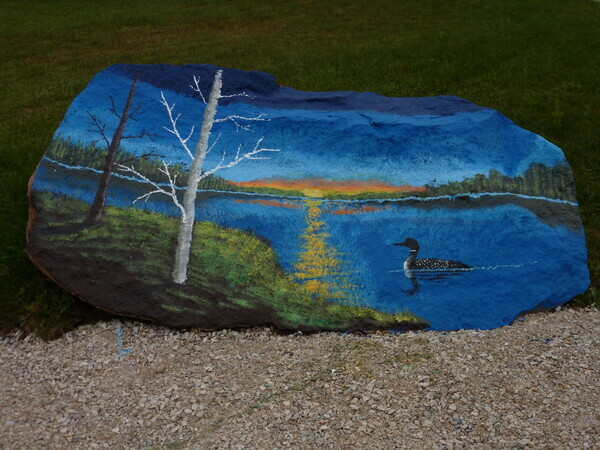
This is the other.
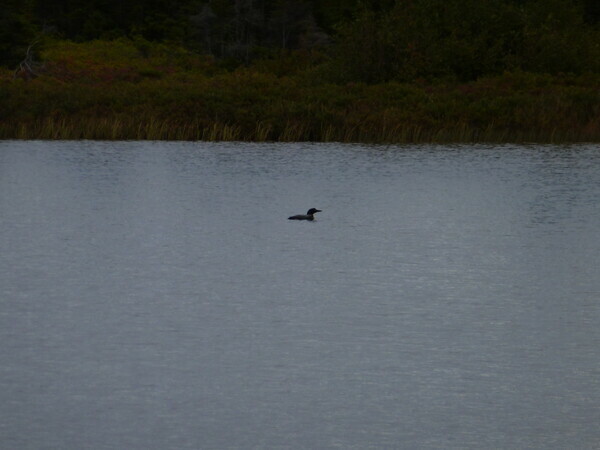
As we started to set up we saw and heard a real loon. It was definately the call of the wild.
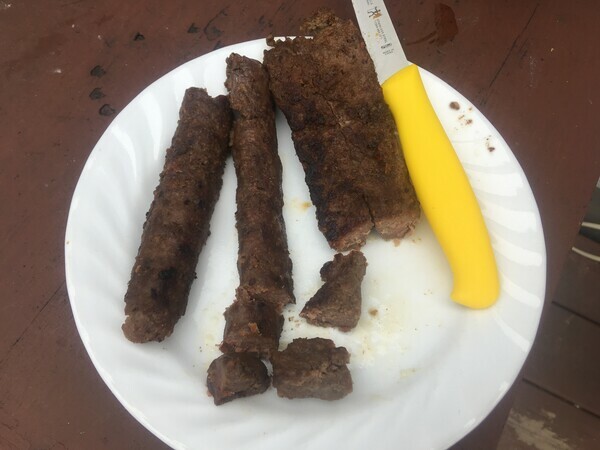
Finally we did it, we tried moose sausage. One of our fellow campers offered us some and we gave it a try. It tasted like.......sausage.
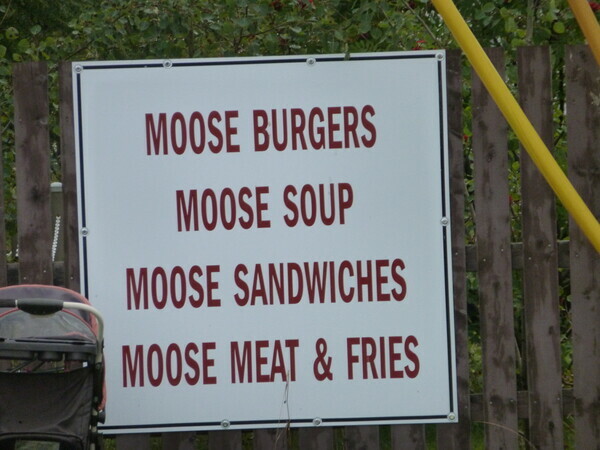
The local restaurant didn't stop at sausage. You could have moose anyway you wanted it!!
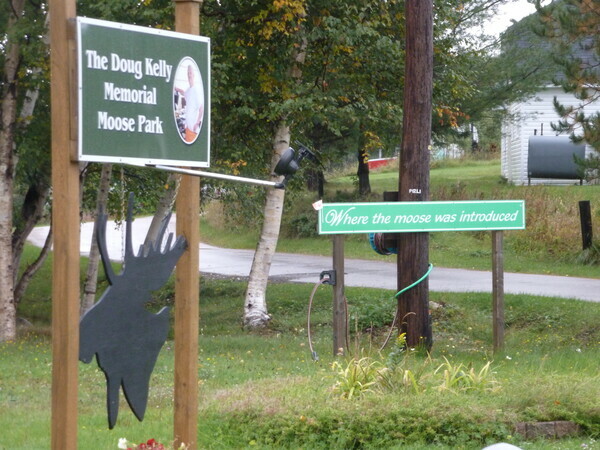
Now the town of Howley has a personal reason for featuring moose on everything. Moose are not native to Newfoundland; they were introduced twice. The first time it was unsuccessful but the second time really worked. They were released in Howley. Now Newfoundland has more moose per square kilometer than any where else in the world. It all started here.
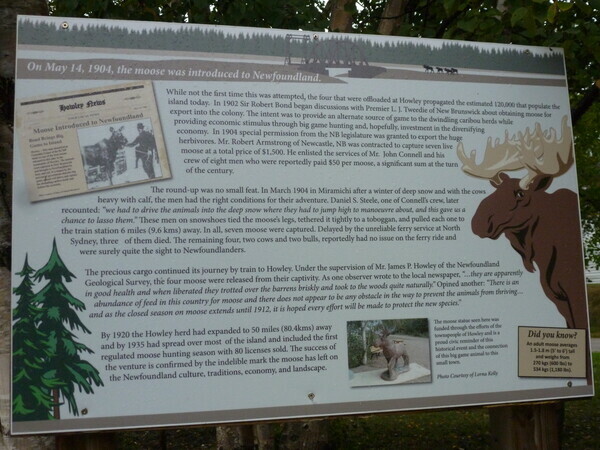
Look closely to learn how they were able to transport 4 wild moose by sled, ferry and train to Howley.
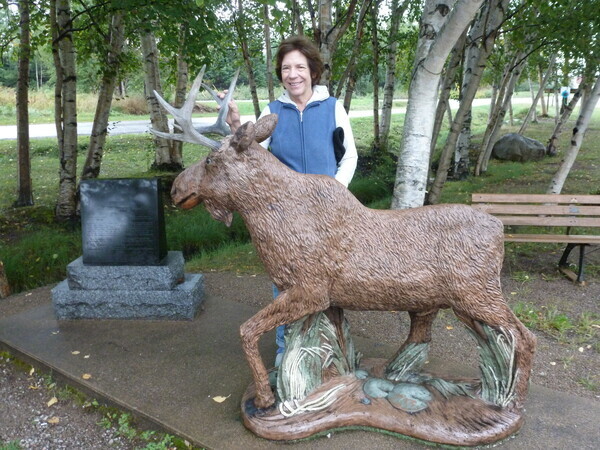
After all that effort moose are very important to the people of Newfoundland. Problem is is that they are a traffic hazard at night and most local people refuse to drive at night in case they run into one. This is a statue of a moose, but with what looks like deer antlers!
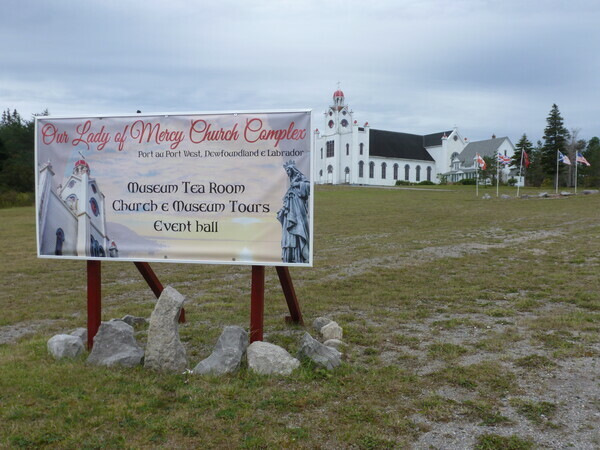
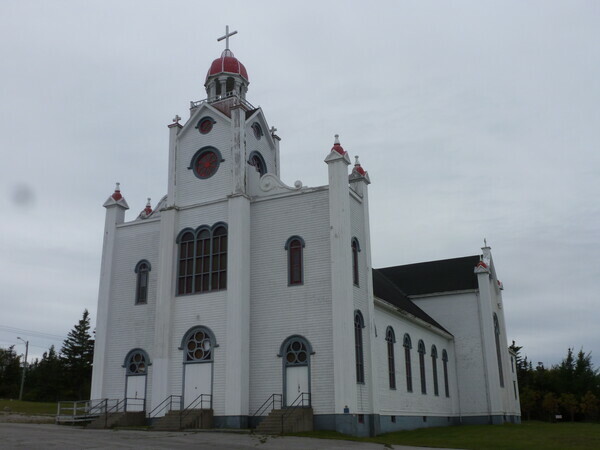
We were wandering around some of the smaller towns when we ran across this Catholic Church. It is said to be the largest all wooden church in Newfoundland with exquisite paneling throughout. It was locked but the sign said that it is open in the summer and the rectory next to it serves tea. We certainly plan to return here.
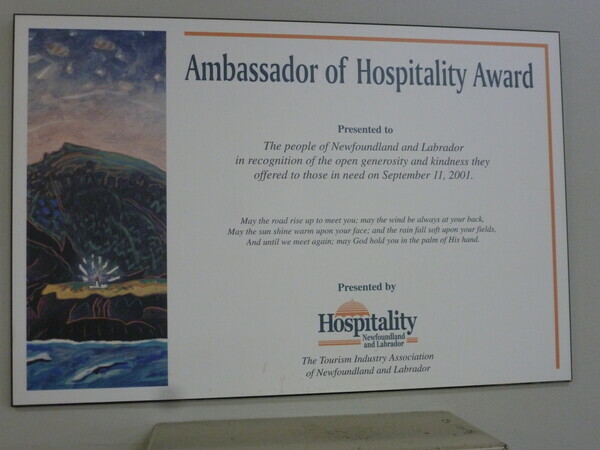
We went to the village of Stephenville because we heard that it had a runway so long it could be used by the space shuttle. Inside we saw this plaque presented to the people of Newfoundland.

Finally we couldn't drag it out any longer. We were intending to stay in Newfoundland until the campground in Codroy closed 3 days later but the rains came. With heavy hearts we boarded the ferry. When we first arrived the sun was out and the air was silvery. Now all was gray and damp.
Newfoundland has very harsh weather. Making a living is hard. The young often have to leave in order to get work. The roads are sometimes a challenge and the villages are far apart. The people are warm, friendly, responsible and kind. Mostly they are content. We really envied them.
As we left we were reminded of something we heard: When you die and go to heaven, how can you tell which of the souls there are from Newfoundland? They are the ones who want to go home. Home to Newfoundland. We understand; we too are planning our next trip to Newfoundland; we want to go home.
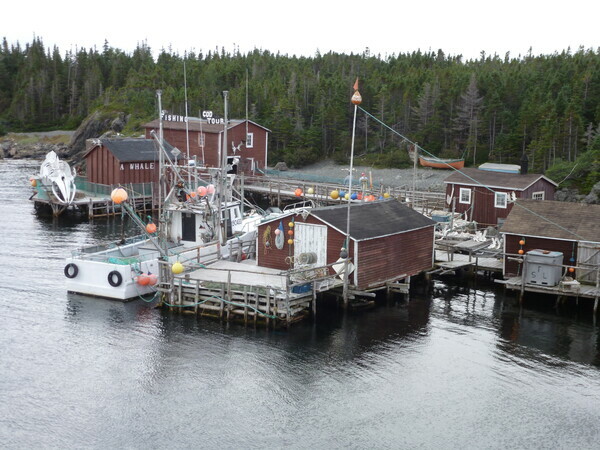
On the way into Twillingate we saw this museum. Unfortunately it was closed but...
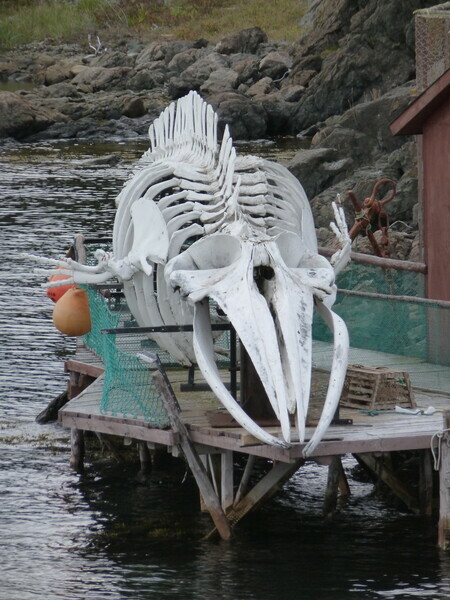
...but what was visible was very interesting. This is a Minke whale skeleton.
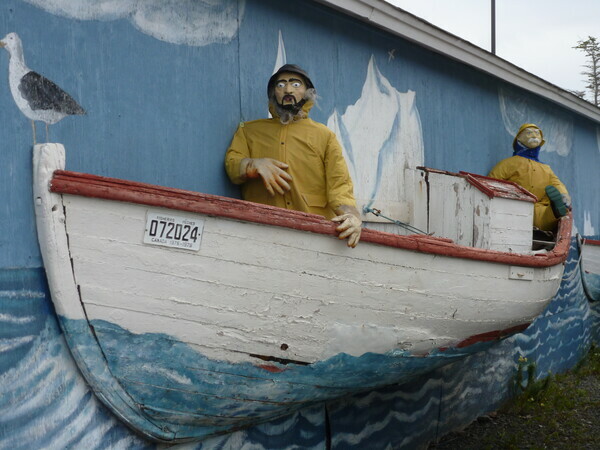
A very creative 3-D mural on the side of the building. Maybe it will be open next time.

In another part of town another interesting mural of creative icebergs.

Twillingate's coastline has many inlets, coves and islands making it a perfect place in the spring to find icebergs and whales.
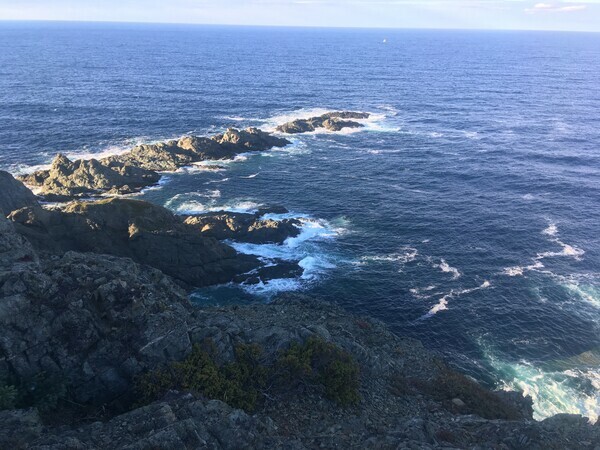
One of the more rugged coastlines in Newfoundland.
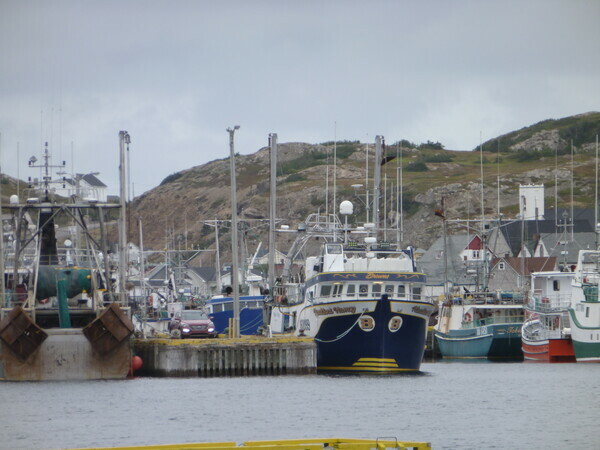
There is quite an extensive and colorful fishing fleet. A larger village than most of the others that we have seen.

This was the view from our campground.
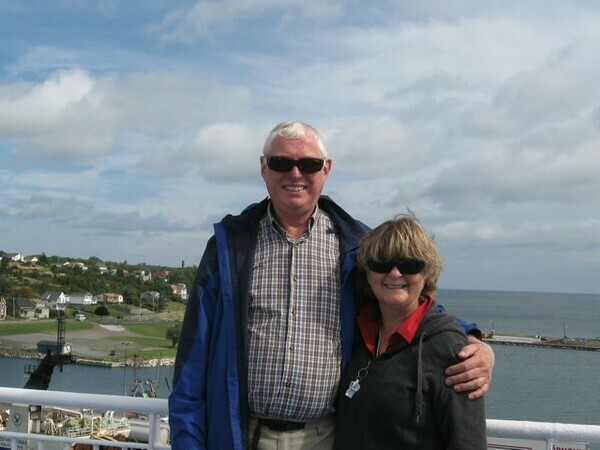
We were so excited to meet up with our friends from the ferr,y Ree and Harvey, at this same campground. We had so much to share and compare that it was like meeting long lost friends even though it was now hundreds of miles away from where we first met.
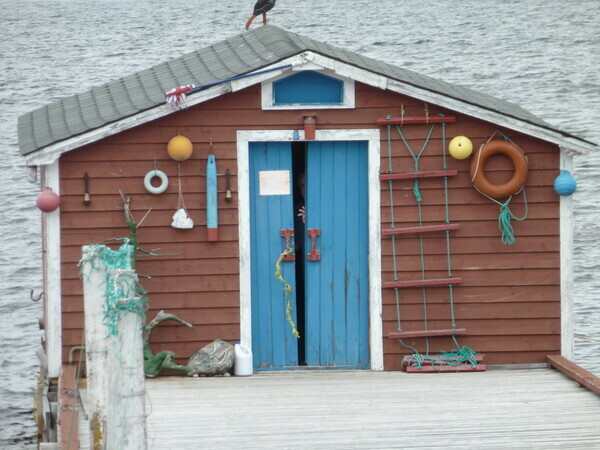
We drove around town one morning and, when we were taking a picture of the fishing sheds, our new friend Melvin came over. He asked us if we would like to see his private museum. Of course we said "yes".
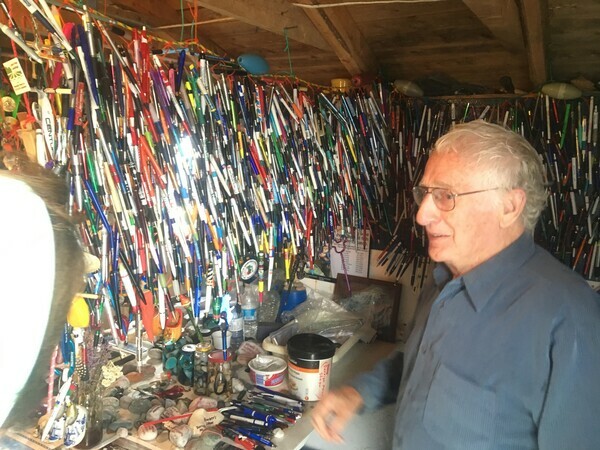
He showed us his collection of pens people had given him that came from all over the world.
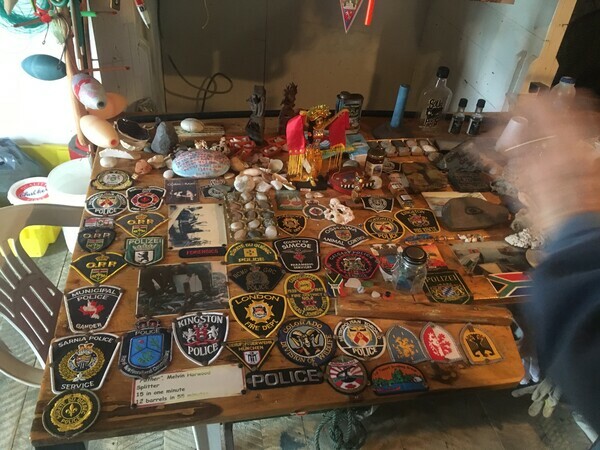
He also had a global collection of badges his visitors had donated to his museum.
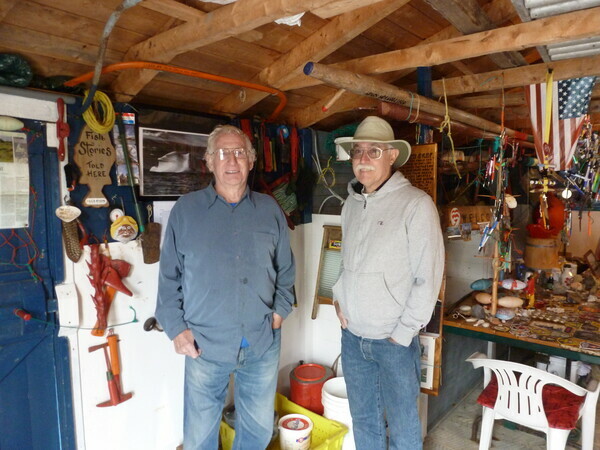
Melvin had been a fisherman, an iceberg tour guide and now was enjoying his museum. When you think about it, it's a great idea. He enjoys people and gets gifts from people from all over the world. He even cleverly has a donated collection of money from hundreds of countries. Smart guy!!
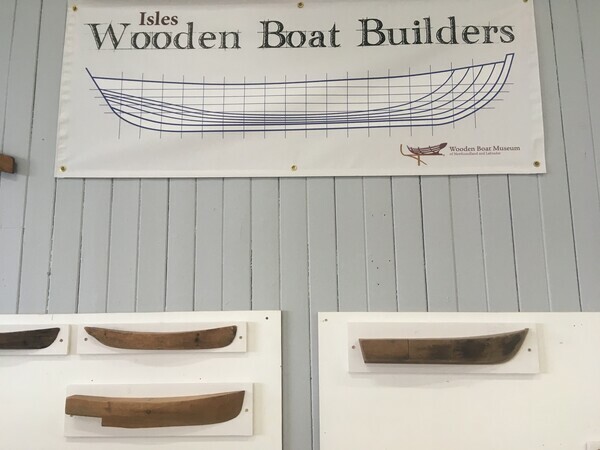
The wooden boat museum was a great treat. It encourages the building of wooden boats, in the old way. As they explained it, hand-made wooden boats can be improved every time you make one, unlike fiberglass or plastic ones that are identical from coming off the same mold.

The volunteers make fishing boats upstairs in the museum and show the various techniques used.

Ribs are made from tree roots of the proper shape. Making a boat is quite a job!

The museum also told about fishing techniques and how equipment was made. Alan got to try his hand at making a net with Sterling, our volunteer.

It is not as hard as it looks, once you have worked at it for a few minutes. This is the type of work that would be done in the winter months.
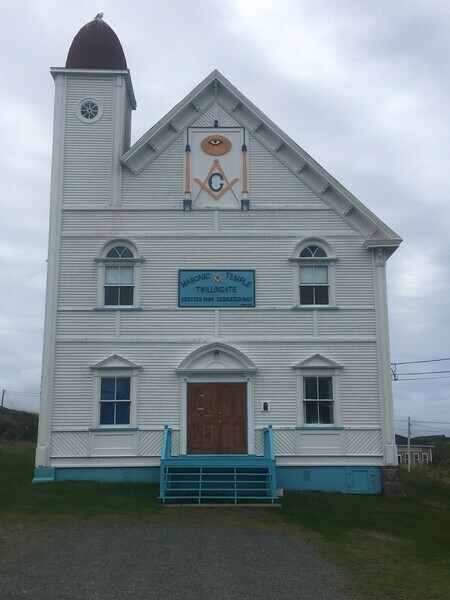
This Masonic temple was built in 1906.
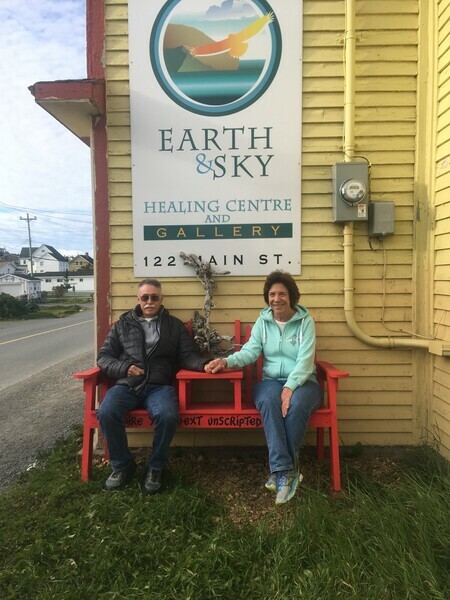
This was one of the most interesting stores, our only problem was that it wasn't open. Now remember that this was Newfoundland; we called the number on the door and explained our need to buy something special for our friends. The owner Joanne, came right down and let us in.
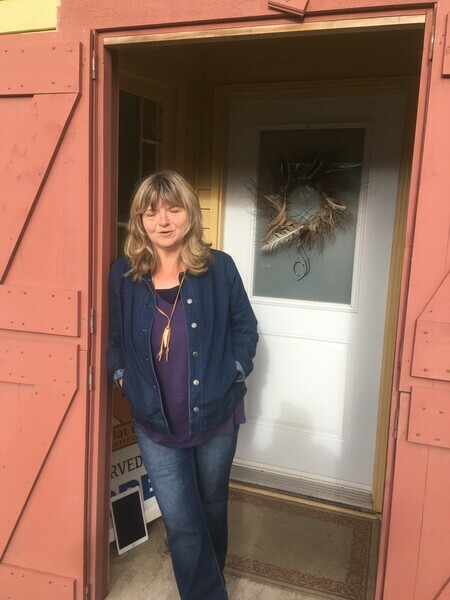
This is Joanne. We spent about an hour together in the shop just talking and enjoying each others company. We consider her one of our very favorite friends. You just never know.

We headed Eastward to the city of Gander. We were interested in Gander because of the current Broadway musical "Come From Away". This musical chronicles Gander's amazing role in helping the US during 9/11. This is when airlines were restricted from US airspace for about 5 days. 38 airlines were rerouted to the airport in Gander, a city of 9,000 became a city of 17,000. The citizens of Gander took up the task of housing, feeding, clothing and caring for 8,000 additional people. The musical "Come From Away" was nominated last year for a Tony for the Best Musical. It didn't win but is a point of great pride to all the Canadians we met. The story is also told in the book "The Day the World came to Town: 9/11 in Gander, Newfoundland".

Gander was once a huge thriving airport and was important in WW-II. It was here that planes refueled before crossing the Atlantic. Now that jets don't need to refuel, there is little airline activity.

Here is the international lounge. It is literally frozen in it's mid-century decor. In the past people like Marilyn Monroe, Frank Sinatra, and Albert Einstein came through here. Now it is empty and waiting like an old movie set.
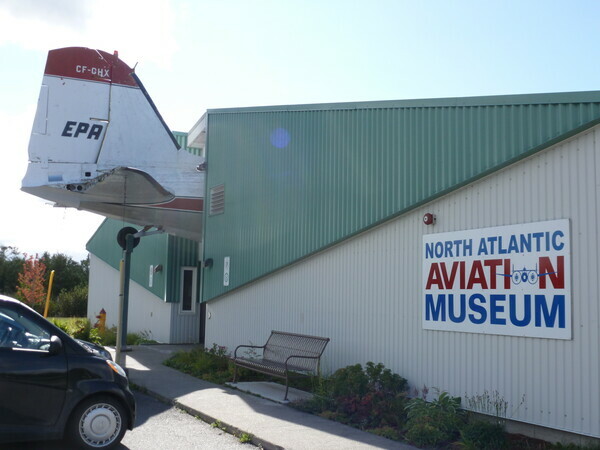
We went to the North Atlantic Aviation Museum to see other aviation aspects of Gander. Quite an interesting outside display of a DC-3 crashing through the museum.
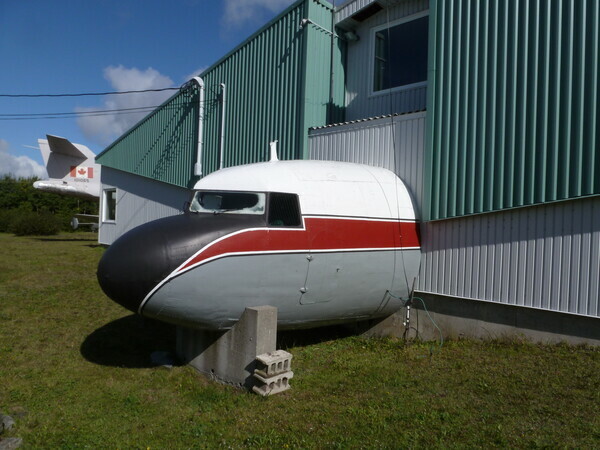
This was the other side of the building.
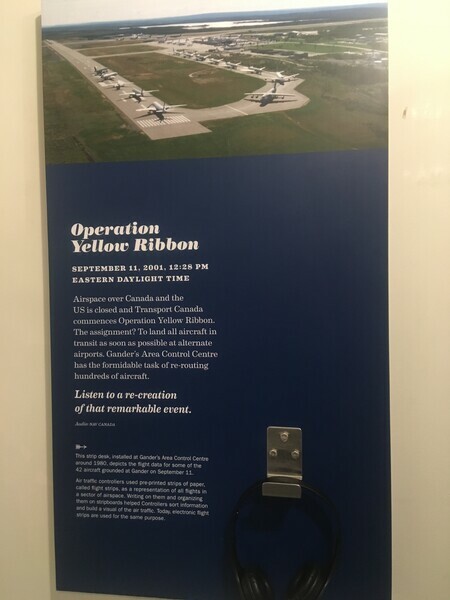
Here is a picture of the planes on 9/11 on the Gander runway. Gander is the only city outside of New York to have a piece of the steel supports as a memorial from the World Trade Center.
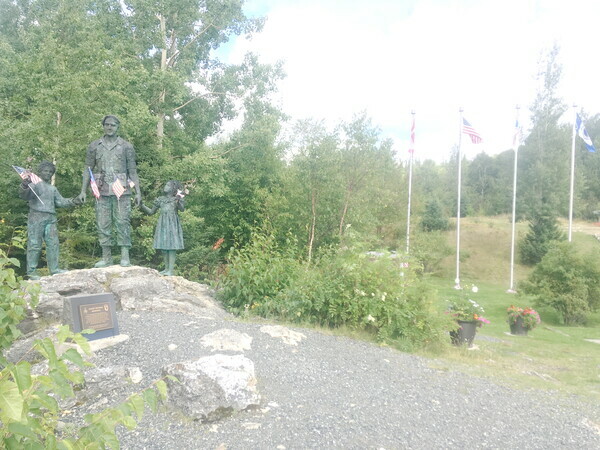
Many people of all ages told us that we should see the memorial to the Silent Witnesses. We headed out of town down a rutted dirt road not knowing what we would find. There we saw this memorial to members of the 101st Airborne unit who died when their plane crashed just after taking off from Gander airport in 1985. They were returning from a humanitarian mission in Africa to spend Christmas with their families. The statue of the soldier on the left is looking towards their home at Fort Campbell, Kentucky. Silent Witnesses alludes to the fact that only the trees and sky were silent witnesses to the deaths of these very fine humanitarians. The people in Newfoundland still choke up when they talk of this horrible crash and it was a Canadian military group that created the memorial. The place is so very peaceful with a natural running stream and wind in the pines.
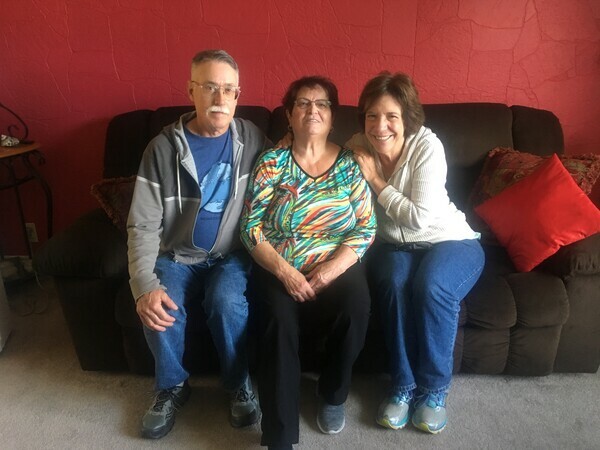
We pushed onward to the East to see our friend from our last trip Freda Stroud in Glovertown. Here we are with her sitting on her "Chesterfield" or sofa. We had a lively lunch filled with many words we had to check the meaning of in our Newfoundland dictionary.
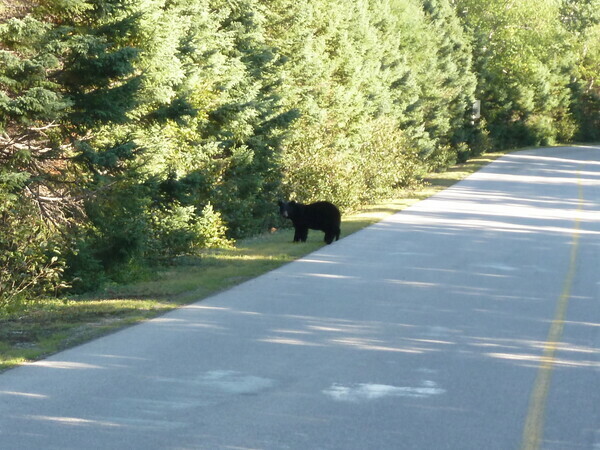
We were on our way to Terra Nova one of the large National Parks in the middle of Newfoundland. We saw something large and dark cross the road and we both thought that it was a Newfoundlander dog. Upon closer inspection, we were pretty excited to see that it was a black bear!!!!
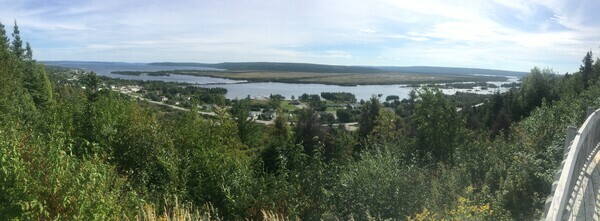
From an outlook we could see the village of Gambo. This was as far east as we were going. We then turned northward to the town of Twillingate famously known as the Iceberg Capital.

One of the main must do things while in Gros Morne is to take the boat tour of Western Brook Pond. You have to first hike over a mile to the edge of a land-locked fiord to catch the boat.
The fiord used to be open to the ocean, but is now separated from it by a marsh area. The water in the fiord is now fresh, and is very pure.

Here we are on the boat with our new friends Karen and Marie. Marie was raised in a fishing village outside of Stephenville, NF. She helped her father salt the fish and worked the long hours that were necessary. She said that sometimes they even ate seagulls. Whatever was necessary. She has recently moved back to NF to help her mom. She worked with Karen, who was visiting NF for first time, in Ontario.
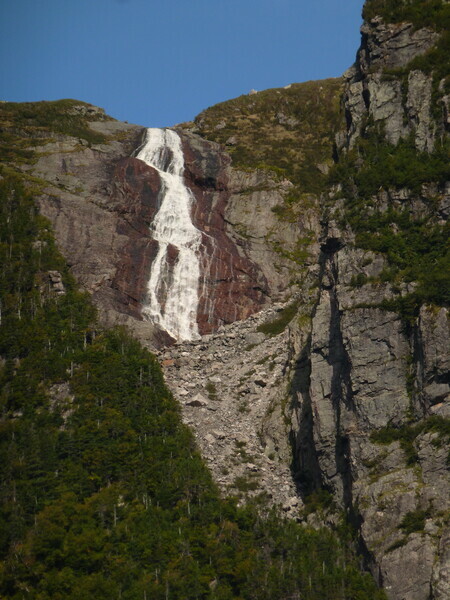
The sides or the fiord are granite with numerous waterfalls.

This is one of the more spectacular ones.
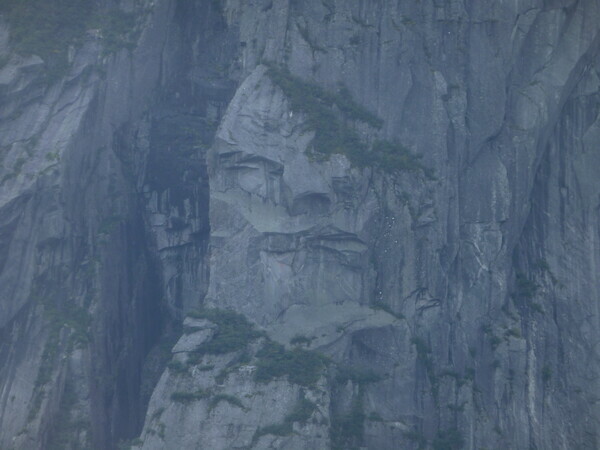
Some rock formations even look like faces. Can you see more than one?
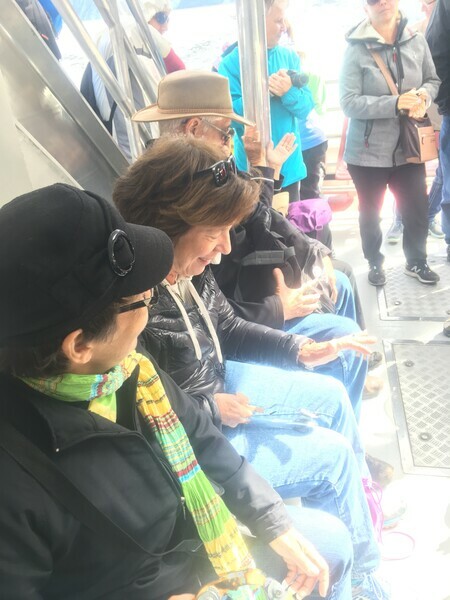
The boat trip was fun with many interesting things to do and see. Here they were playing Newfie music with Mary Ann was playing the spoons. The crew provided homemade instruments, the spoons and the bottle cap tambourines. So much fun and laughter.
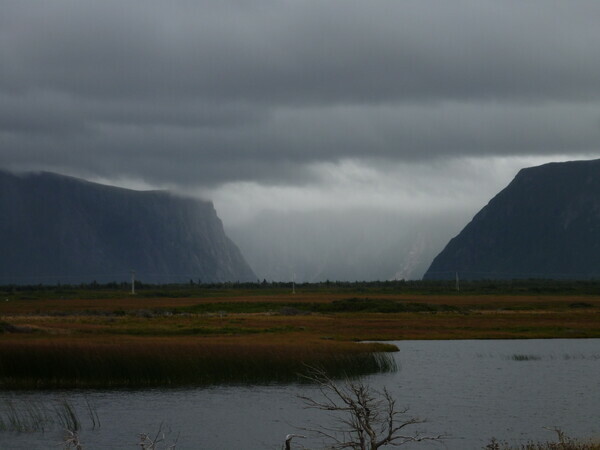
As we left the boat landing the weather changed. You can see the fiord is covered in clouds. The area in front is part of the marshy barrens. Many people hike out of the far end of the fiord to Gros Morne. You have to prove you are qualified for such a hike before they will issue you a permit. There are no trails and you have to be proficient with navigational GPS.
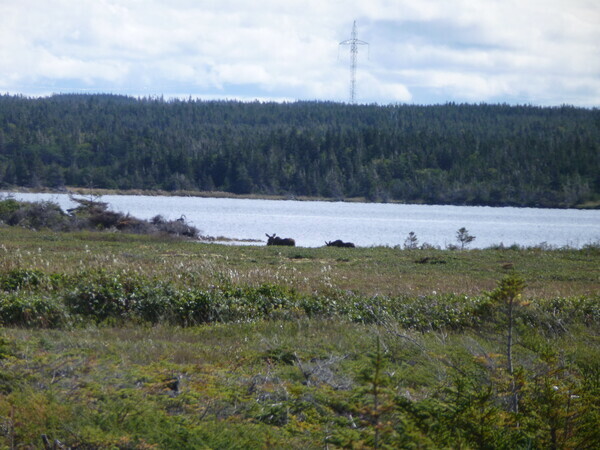
Although there are many warnings about the dangers of hitting a moose while driving, these were the only two moose we actually saw. We figured that it was probably due to the fact that it was hunting season and the moose moved away from the areas that humans were.
Next, to Gander and Twillingate!
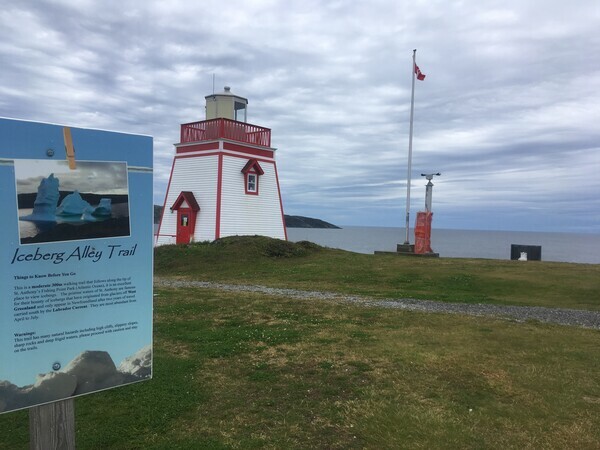
At the top of the Northern Peninsula is the Town of St. Anthony. At the tip of St. Anthony is this lighthouse which looks out at what is called "Iceberg Alley".
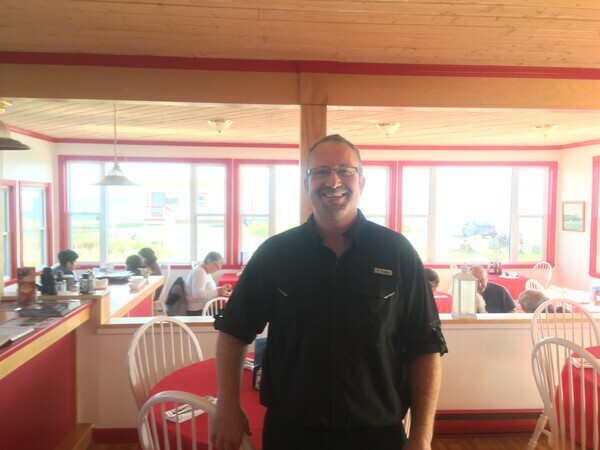
This is our new friend Chris. He and his wife put all of their savings into this great restaurant called Lightkeepers Sefood. It is located right by Iceberg Alley. We thought he reminded us of our friend, neighbor, chef and former restaurant owner, Tim Klepeis. What do you think?
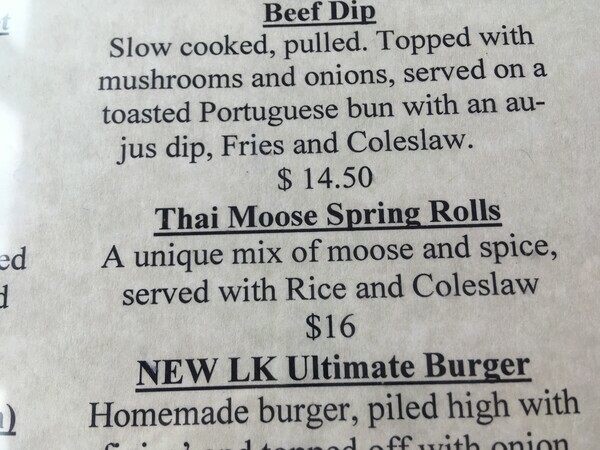
This is a sample of his interesting menu. Not only were there Moose Spring Rolls but Moose sliders too!!
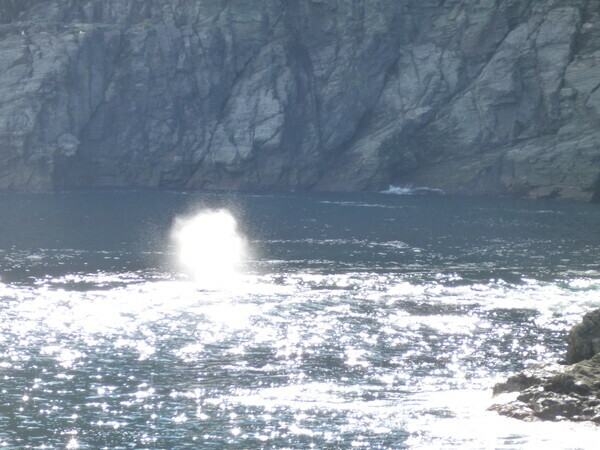
Right across the street from the restaurant was a gift shop. The owner noticed some dolphins out the window. As we were watching we were told that there were no whales this late in the season. Well.....this is what we saw just minutes later.
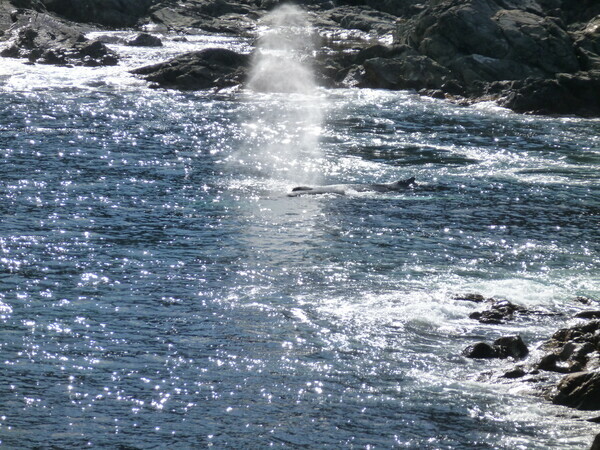
Two whales were coming right by the cliffs we were on. They got so close that we could hear them breathing.
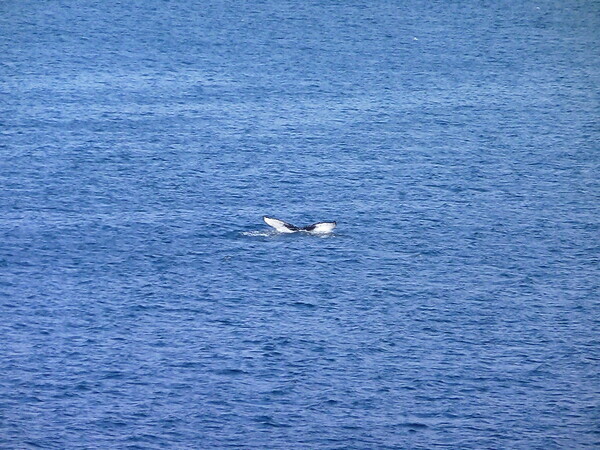
We watched them and saw them surface and dive several times.
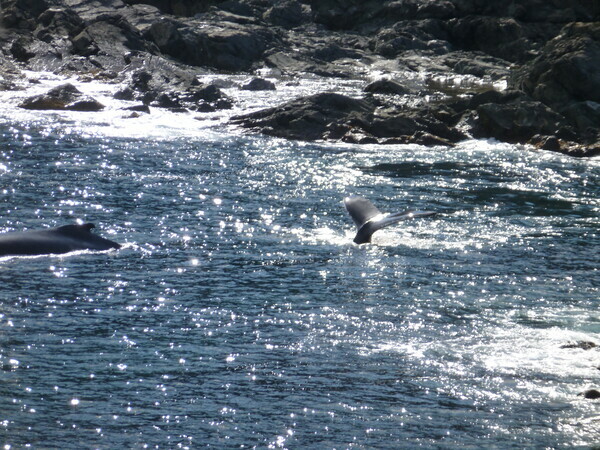
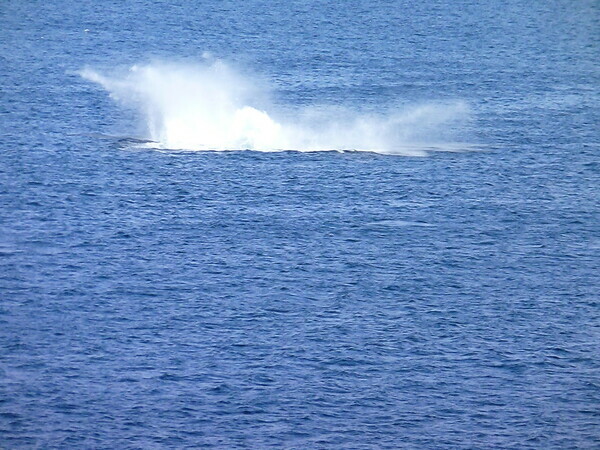
They then swam to the cove on the other side of the lighthouse and jumped straight out of the water followed by a third one who also jumped. Alan was following them with the camera but all he could get was the after-jump Big Splash. They were three Humpback whales and the sight was amazing!!!
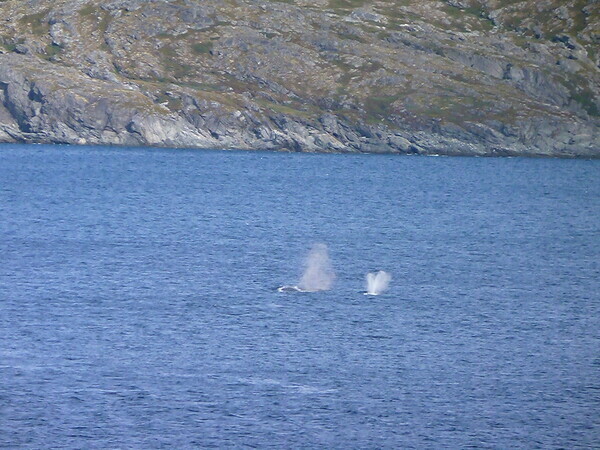
Every so often we would see them breathe but they didn't jump again. It was such a special treat to see these whales for so long and so close!
The lady in the gift shop told us that two years ago they had a huge ice slab. It extended from one side of the cove to the other. It had everything on it, waterfalls, seals, and an array of birds. It must have been a sight to behold!!

We visited the Wilfred Grenfell museum. He was a doctor who came to help the fishermen along the Labrador and Newfoundland northern shores and their families in the early 1900s. He was one person who really made a difference. Starting when he was about 26, he was a doctor, minister, helped start the hospital, orphanage, and the co-op stores. His faith and his doctoring by boat brought all in the area up to a higher level of living. He created a health-care system that was eventually incorporated into the overall region's system.
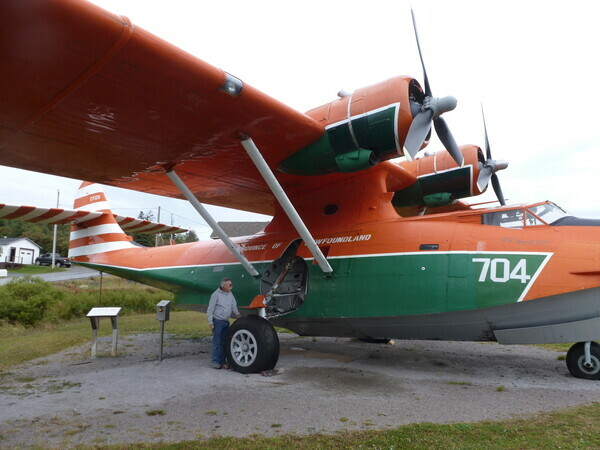
This is a PBY aircraft modified for scooping water for fire fighting. Made by Consolidated in San Diego. It was on display as a memorial to all flyers who were members of the Fire Fighting Service.

On our way down the peninsula we noticed some interesting buildings. We think this boat was a front yard ornament which doubled as a clothes line.
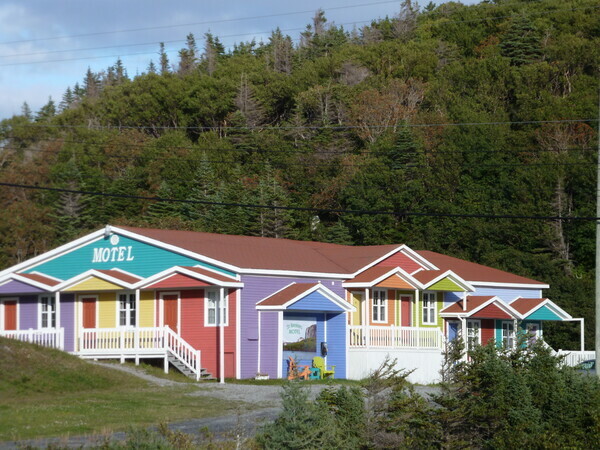
Here is another building painted in the Jellybean colors.
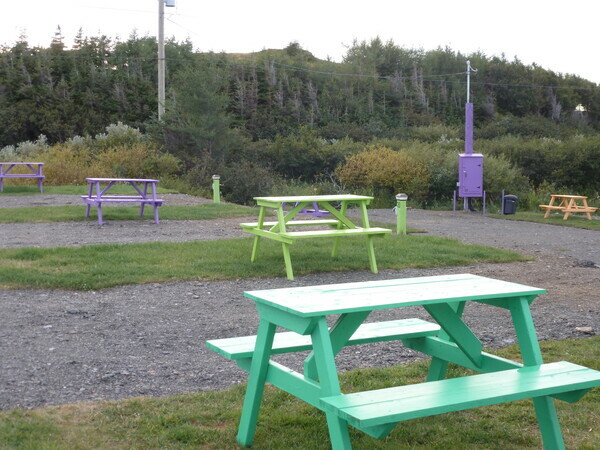
We even stayed at a Jellybean campground. The colors were so clean and bright. Definitely a cheerful place to stay.

This Noah's Ark replica was a produce store.

We returned to the Gros Morne Visitors center and Emily, our favorite park ranger.
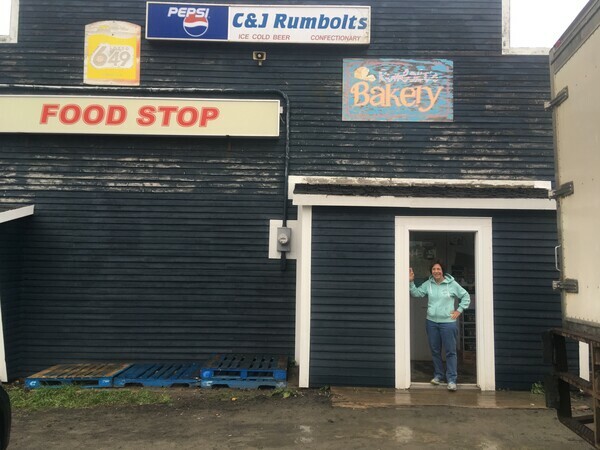
We decided to stop at the local and only grocery store for supplies. The parking lot was mud and the front wasn't very inviting but it did say it had a bakery.
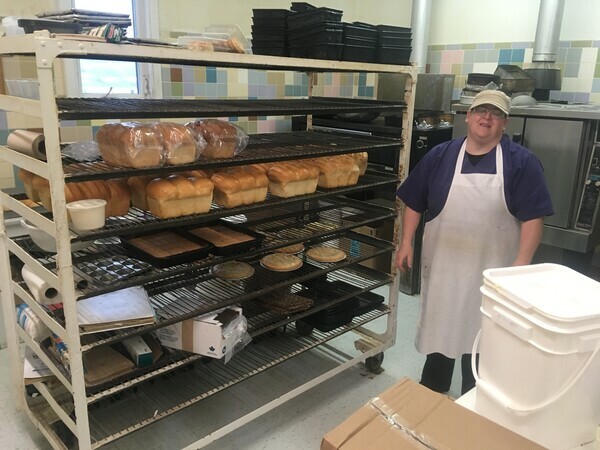
Out in the store we didn't see what we wanted so they said to go into the back. There we met Tracy the baker. She makes everything from scratch and we found what we wanted. The aroma was heavenly.

We thought these old scales, that she still used, were a classic. It goes to show that you never can tell what you will find in one of these stores.

This was taken by one of our favorite campgrounds in the village of Cow Head. The camp site had only eight spots and opened on a small bay. Cow Head is also famous in this are for its Gros Morne Theater. We went to a performance and were very impressed by all that we saw.
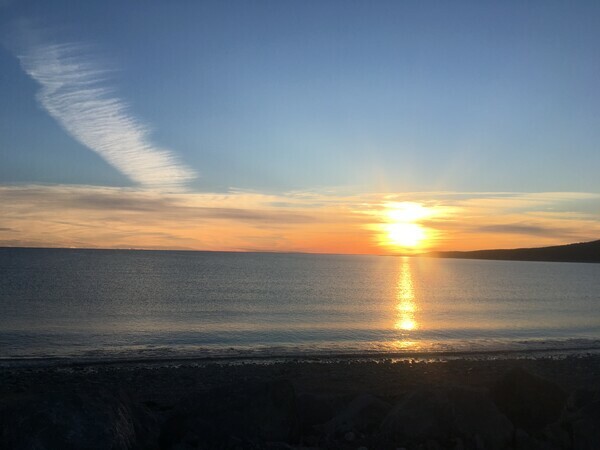
One of the reasons we liked Cow Head so much is that this is the sunset from our campsite.
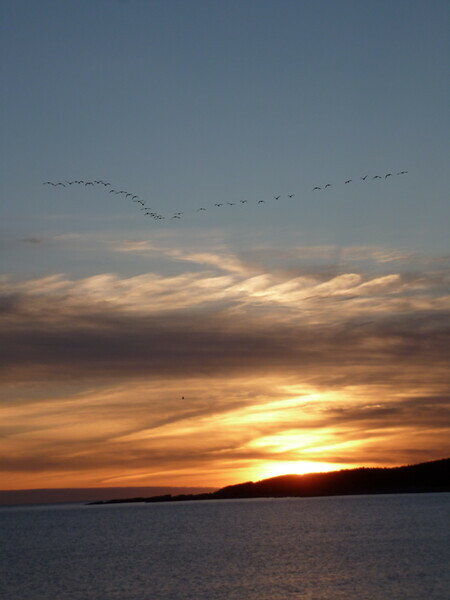
Another sunset shot, with geese.

The next morning, again from our campsite, was a glorious sunrise!
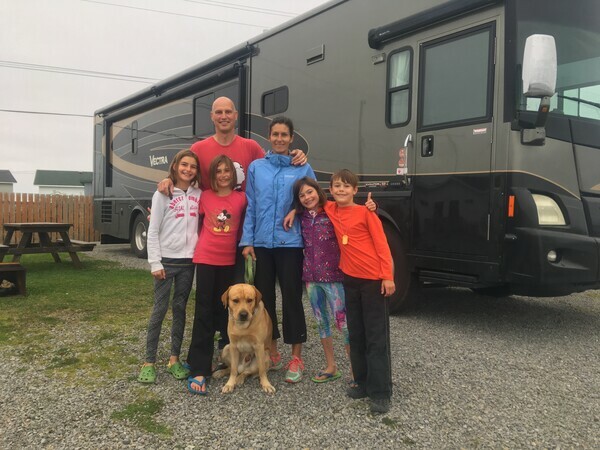
This was a young family we met at Cow Head. No, your eyes are not tricking you, they have TWO sets of Twins!! They are from Banff and are on a year-long tour including the US east coast, Columbia in South America, and parts of the western US. Very nice family and very nice kids!

We now headed north to L'Anse aux Meadows, the site of a 1000 year old Viking settlement. Along the way we saw many typical Newfoundland north coast things such as roadside gardens. Newfoundland is pretty rocky without much soil for growing crops. When the roads were made, in the 1950s, dirt was scraped to the sides, so those areas had deeper soil. The people use these areas to grow their vegetables. You see lots of them, mostly far away from where anyone seems to live. Plots are tended by families, generation to generation.
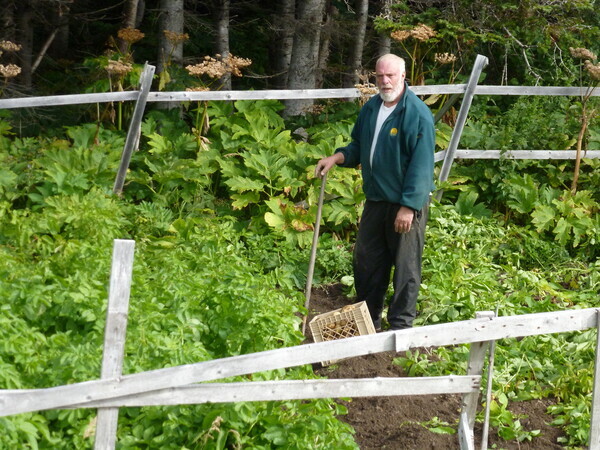
This guy had one of the best looking roadside gardens. We noticed him digging up his potatoes and we stopped to talk. He said this was his parents garden that they started after the road went in. While we chatted a car slowed down on the street to make sure everything was ok. He assured them it was and they went on. Another car came down the street and zoomed on by. After a minute or so we noticed that the second car that had passed was coming back down the road in reverse!!!! He too wanted to make sure that everything was ok. In Newfoundland seems that everyone helps each other all the time. It just felt so safe.
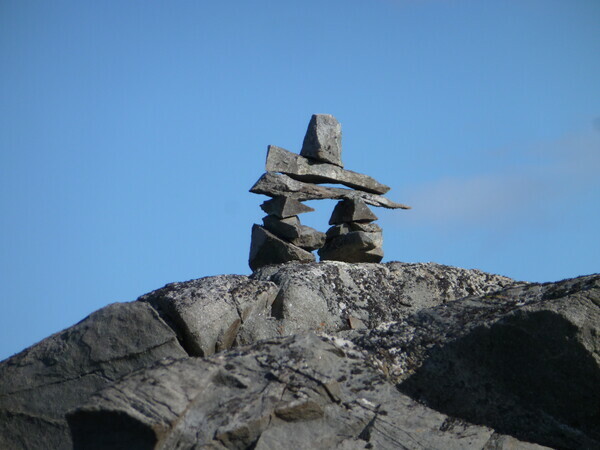
...cairns, or inuksuk, which are man-made landmarks for navigation. They were once prevalent along the Labrador coast. This is one of several we saw.
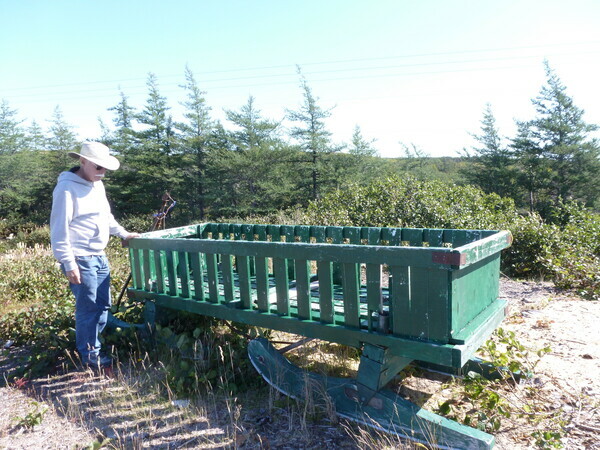
... a komatik. They are used for hauling firewood and other things in the snow. They are usually close to piles of firewood along the road. Families would cut firewood and leave it on the side of the road to season before taking it home. No one would take another family's firewood.
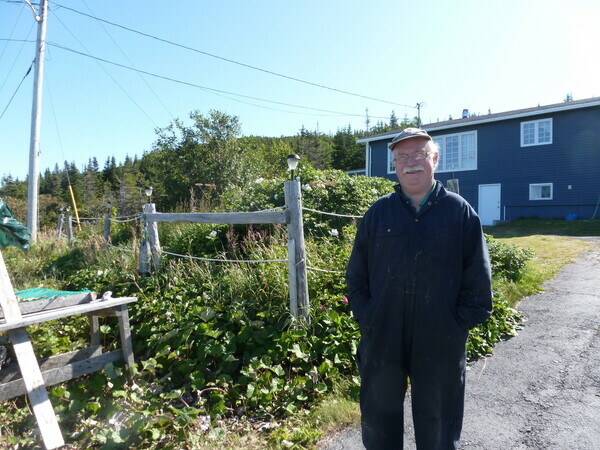
This is my pal Duncan. We were just driving along toward the Viking settlement when I saw a green plastic bag flapping in the wind. It caught our attention so we stopped to see what it was. Duncan was painting his garage door and came over.
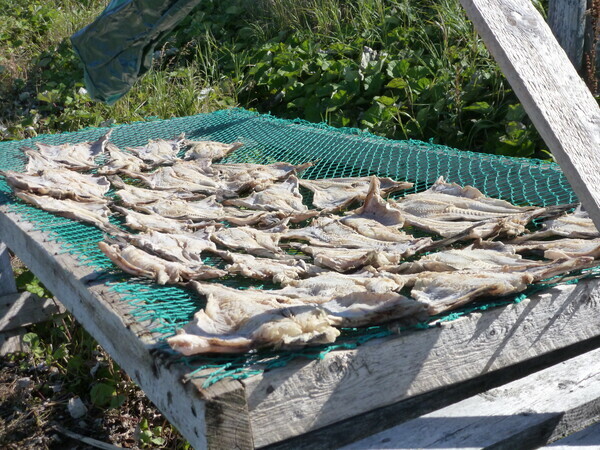
Duncan had salted his cod like his ancestors had done and was drying it out in the front yard. He used the plastic bag blowing in the wind to keep the flies off.
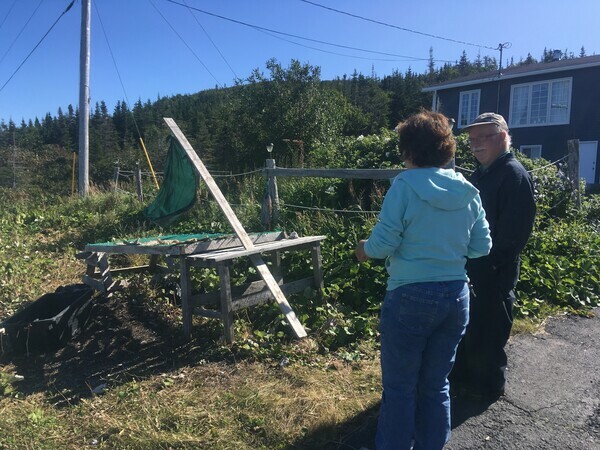
He,like all of the Newfoundlanders we met loved having new people to talk to. Newfoundlanders are noted all over Canada as being the friendliest of people. We have to agree we have never been with a more pleasant, compassionate, helpful, and warm group of people. There is no stranger danger. It felt so wonderful.
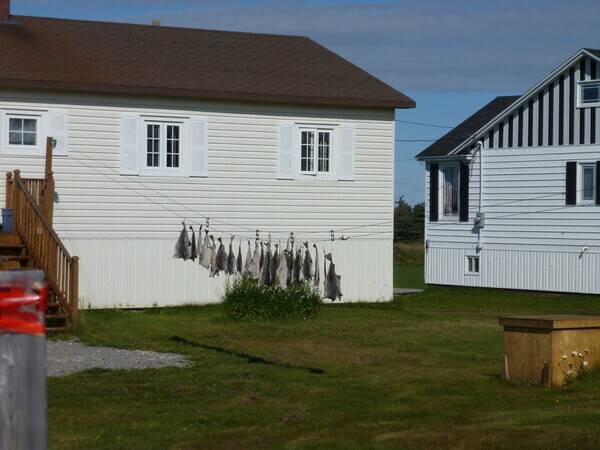
This family just pinned their cod to the clothes line! We can only imagine what the clothes smelled like!!! Such ingenuity!!
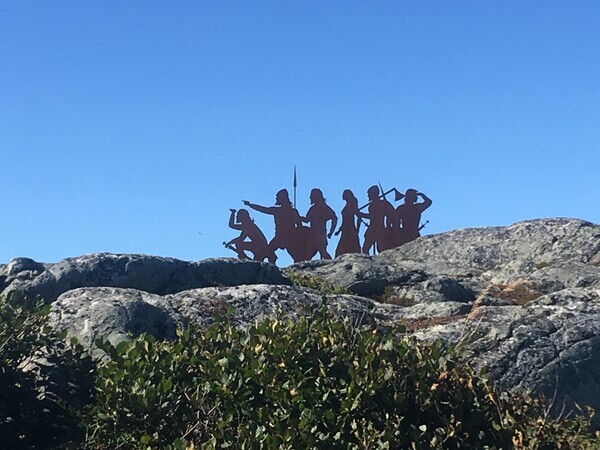
Then, in the distance, we saw this, the entrance to L'Anse aux Meadows.

These are the remainents of the original settlement foundations. Close by is a reconstructed village.

The buildings were made of sod and wood. In addition to exploring these new lands, the Vikings returned home with wood, fish, and crops not available in Greenland. They came and went over a period of about 30 years.
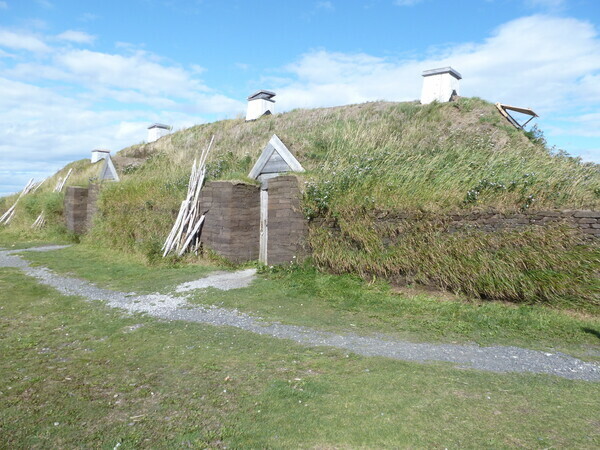
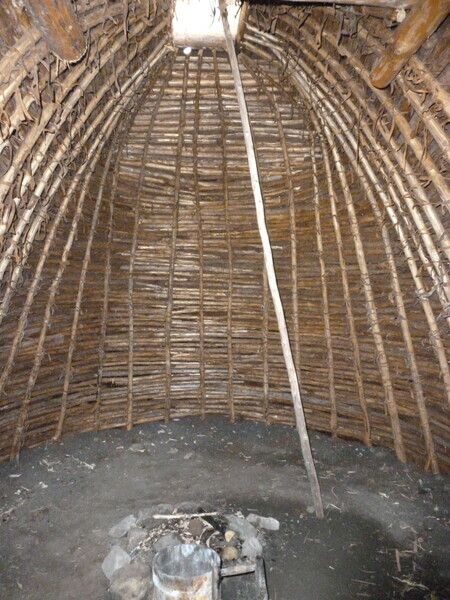
This is the inside of the slave's quarters.
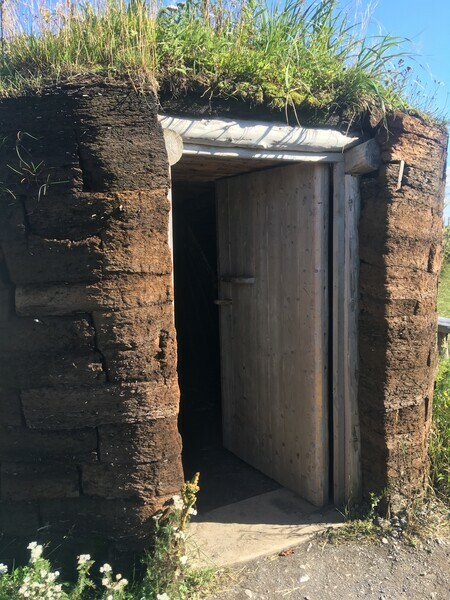
You can see the layers of sod, which probably insulated well.

Inside were people reenacting how they must have lived. The long house was furnished and embellished in typical Viking style, based on what was discovered on the site.
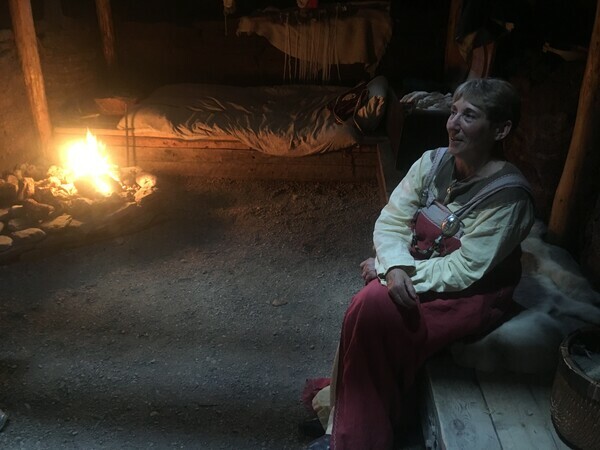
This woman was weaving when we were there.
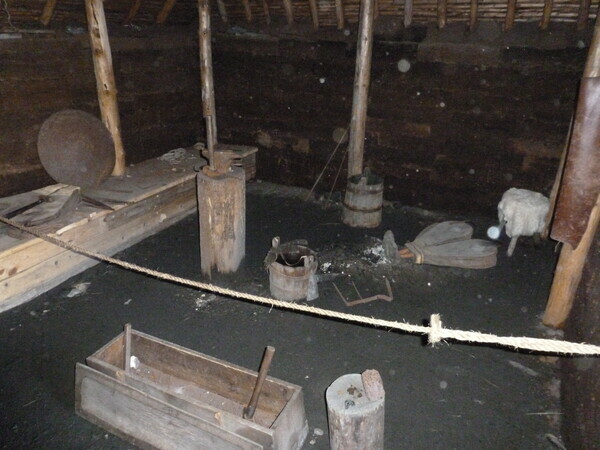
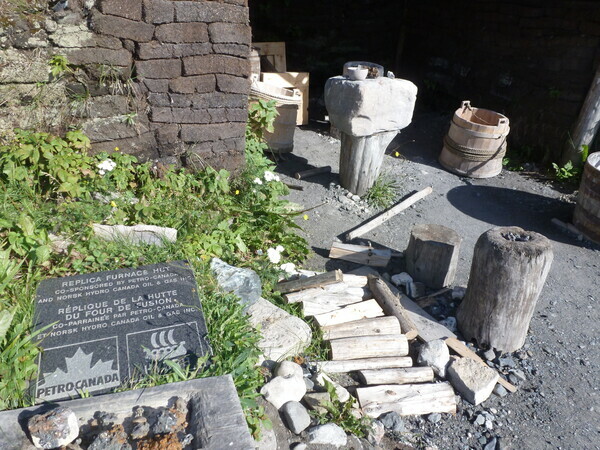
These two photos show the blacksmith furnace area. The Vikings knew how to make steel. One reason they chose this particular spot was because the water was a dark rust color, indicating an iron-rich area.

They do look like they belong.

We don't look much like Vikings!
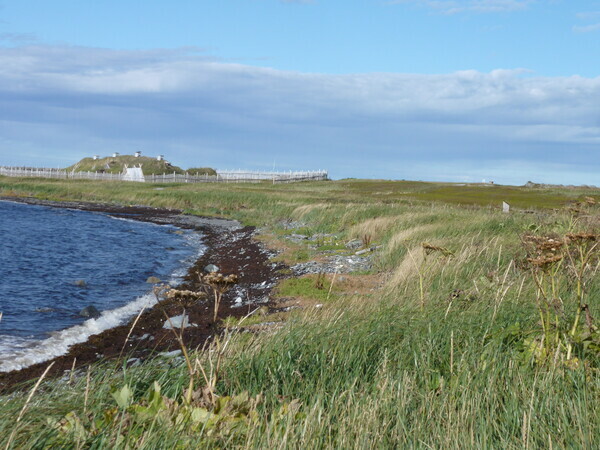
After the ruins there is a mile long sea cliff trail that goes along the shoreline on to the cliffs and across a bog. You get a good idea of the surrounding area.
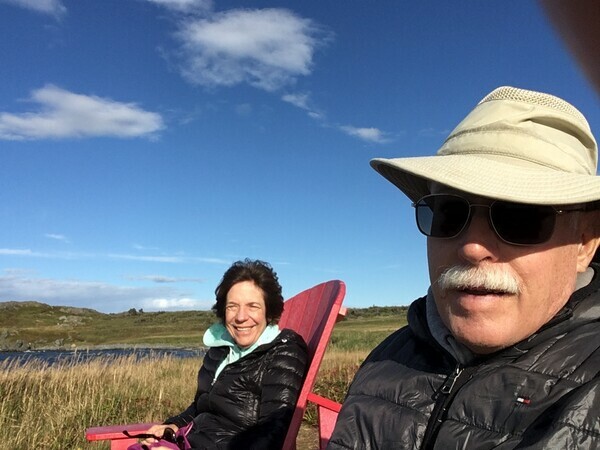
On one hill we found these chairs set up for a mid-trail rest. We couldn't pass them up!!
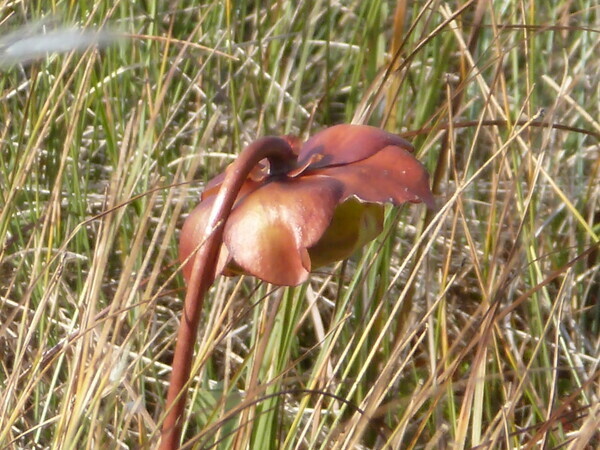
In the boggy area we saw this insect-eating plant. This pitcher plant is the floral emblem of the province of Newfoundland and Labrador.
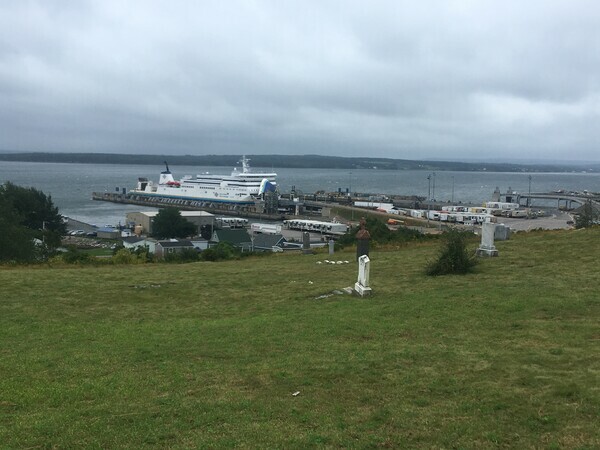
The early morning ferry to Newfoundland.
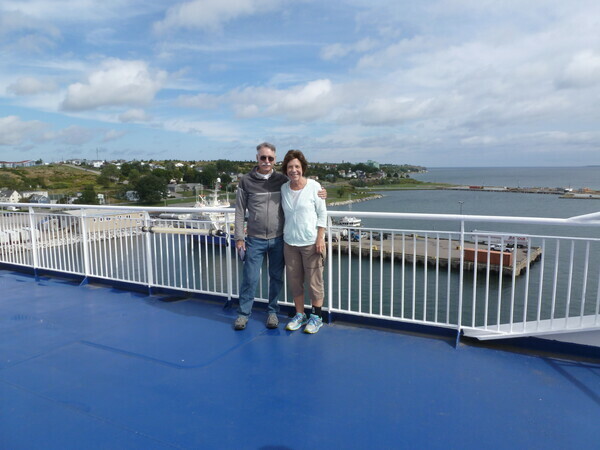
On the ferry to Newfoundland, at last!
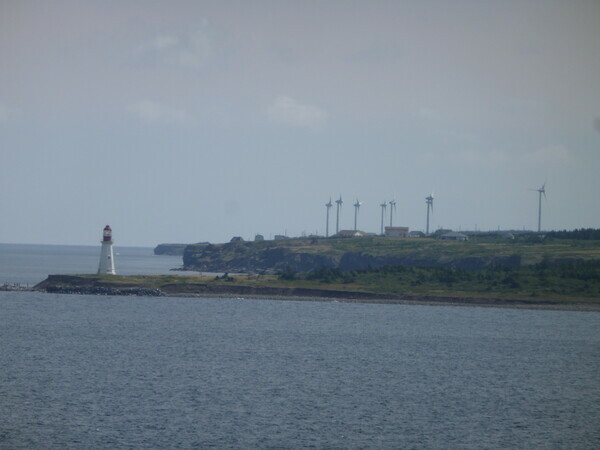
Leaving the harbor in Nova Scotia.

Dinner on the way over.
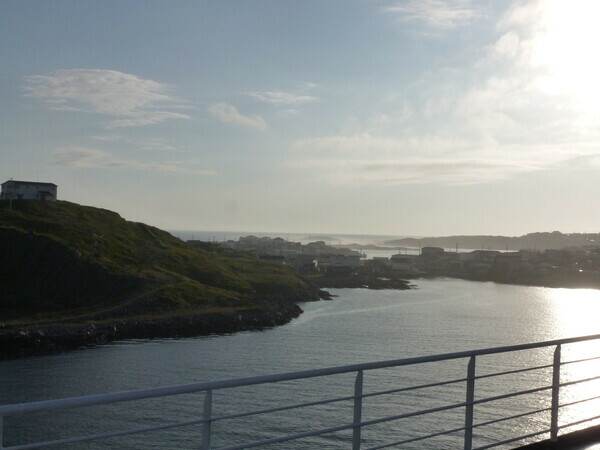
Approaching Port aux Basques, Newfoundland. As you can see even the incoming light seems different, more horizontal then vertical. It seems to have a silvery shimmering glow. Right away you know you are somewhere unlike any place you have ever been. There is magic in the air!!!
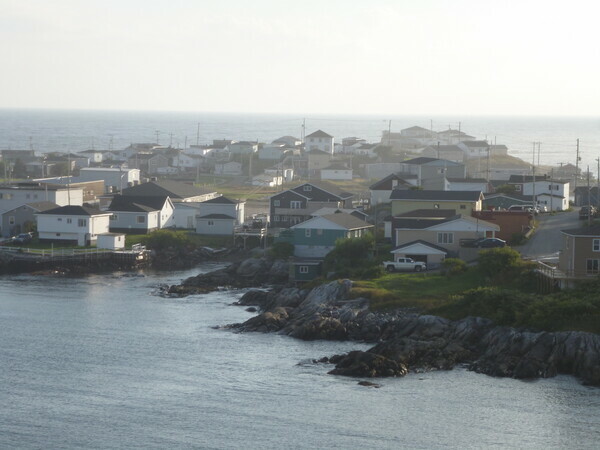
Part of the town of Port aux Basques. This is a typical but rather large fishing village. We have never explored it because we don't get to NFL until the late afternoon and we are rushing to get to the campground before dark. Someday we will take the time to explore it!
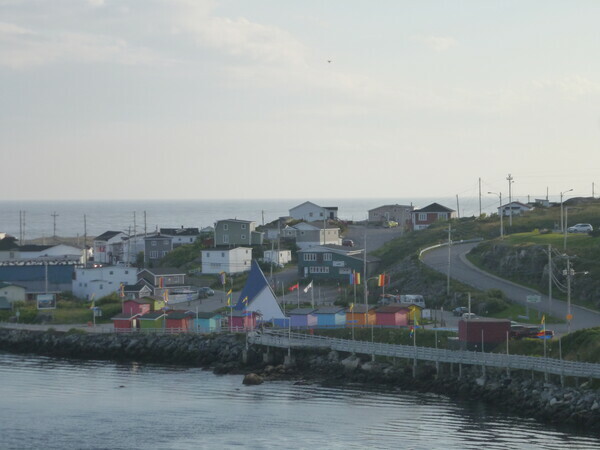
Something that identifies NFL are the "jelly bean houses". They are brightly colored and so cheerful. The capitol city of St. John's is alive with jelly bean houses. I am sure it makes people feel better during the long hard winters.
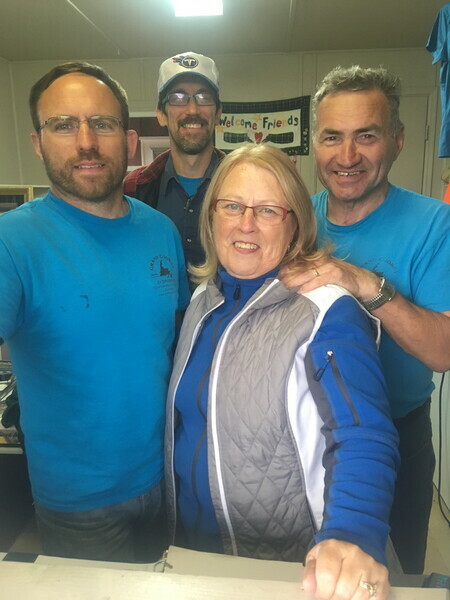
Here are our friends Alice and Dennis the owners of the Grand Codroy camping park. Their son Jason on the left and handyman Phillip in the back. Alice is the unofficial NFL greeter. She practically runs out to your car, opens her arms and says "Welcome to Newfoundland!!" She helps you get your feet on the ground, get orientated and then sends you off for many an adventure. She is an angel and is loved by all.
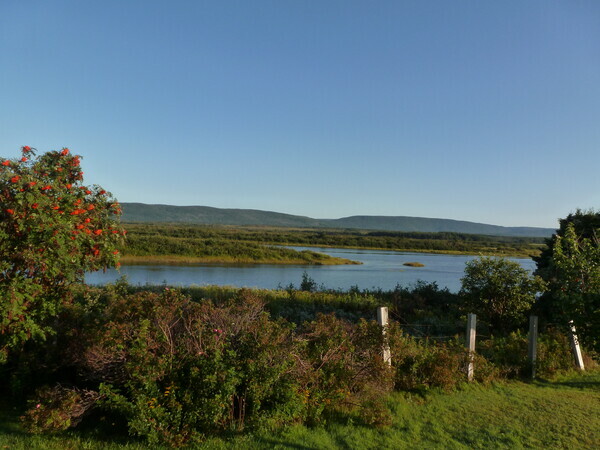
First stop is Grand Codroy RV Park, run by our friends Alice and Dennis. This is a view from our campsite.
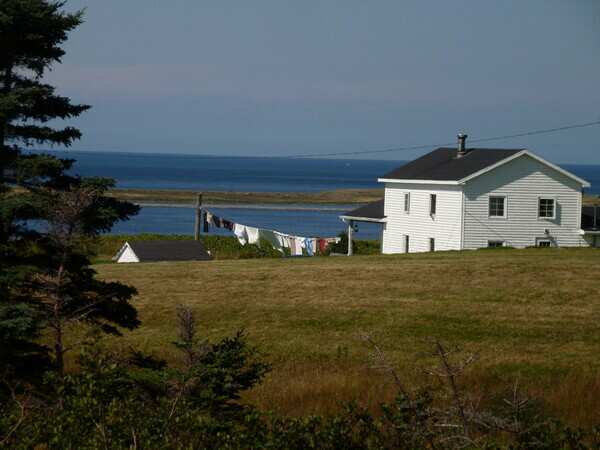
We stayed two days in the area and drove around the valley. Another typical view in NFL are the clotheslines waving clothing with the ocean in the background.
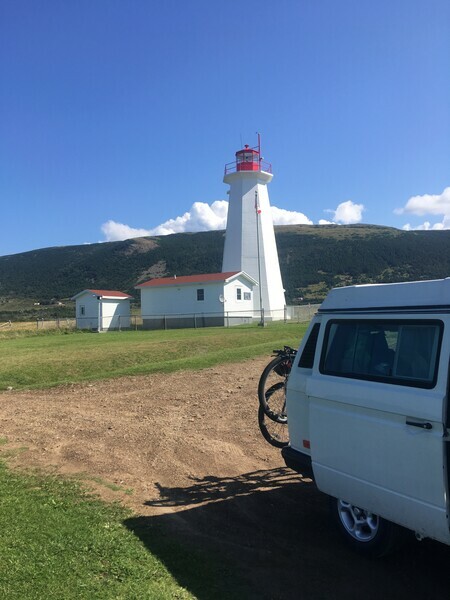
The lighthouse at Cape Anguille in the Codroy Valley. We walked along the shoreline and explored.
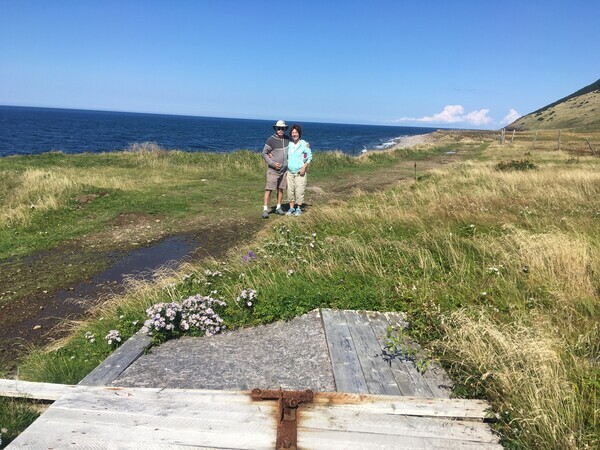

The rugged coast of Newfoundland has many wrecked boats.

Tuckamores, where the wee folk live! The elves and fairies are known to inhabit these holes and cavities.
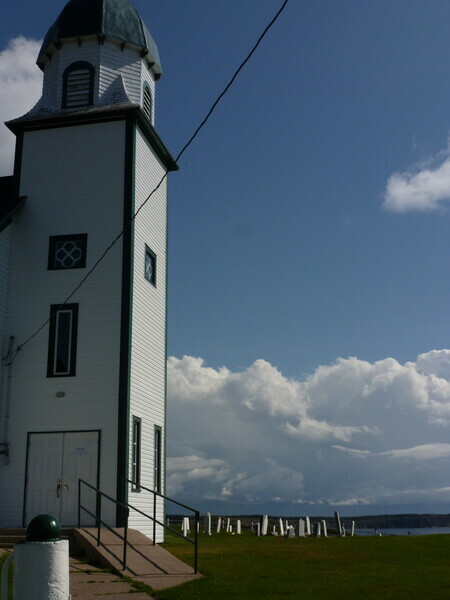
Codroy Holy Trinity Church near the lighthouse. The original was destroyed by a tornado so strong that there wasn't even an original stick left. This new one was built stronger shortly after 1900.
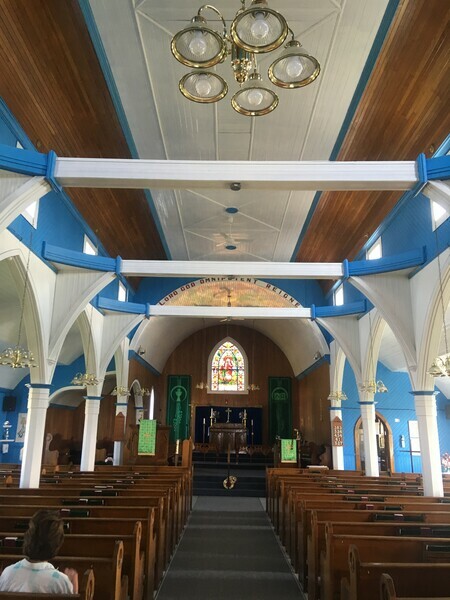
The interior. Note the strengthening beams. It is still standing!!

It is so very peaceful.
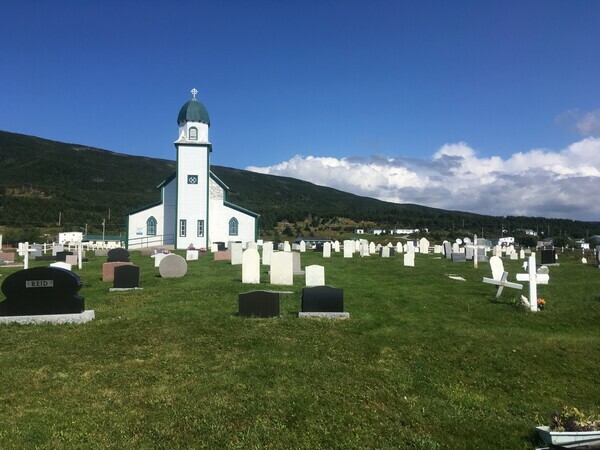
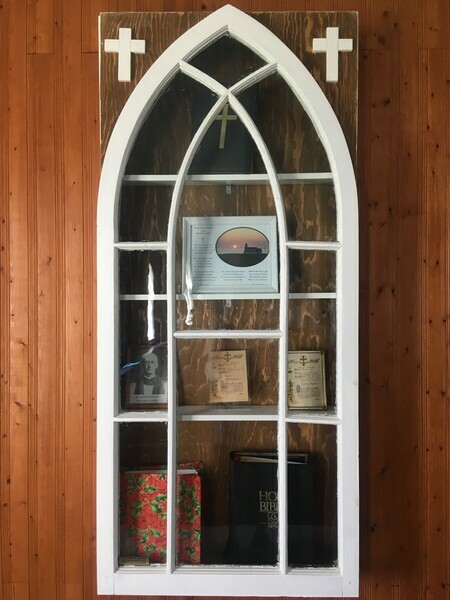

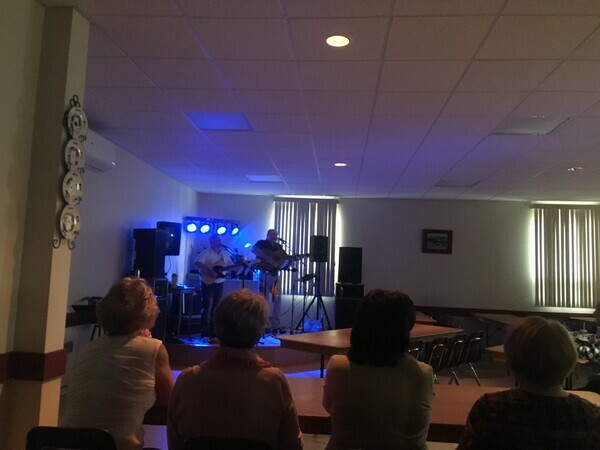
Alice took us and a couple of other campers to hear a country-western group at St Anne's church one evening.
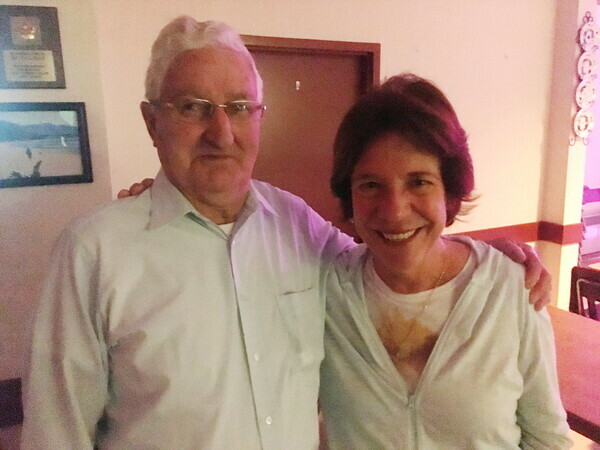
We met Jimmy there. He thought there was going to be a dance there that evening, because he loves to dance. His 82nd birthday was a couple of days earlier so we gave him a CD of "Come from Away". He offered us the use of his house if we come back in the summer. The only fee would be to dance with him!!
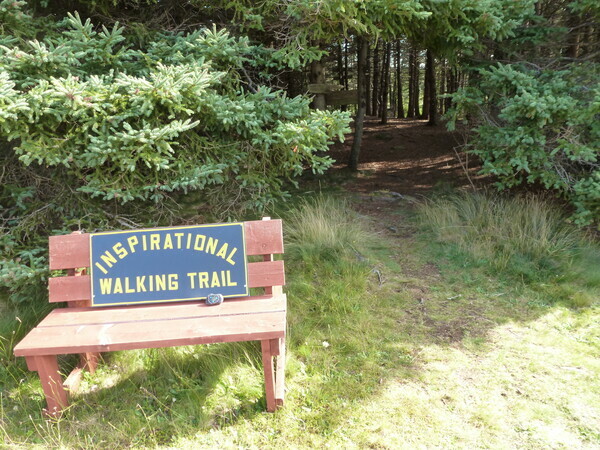
At Alice's campground, they have made this inspirational trail through the woods. Along the way are signs with sayings on them. It is about 1/2 mile and wanders through the woods with little bridges, streams, and magic.
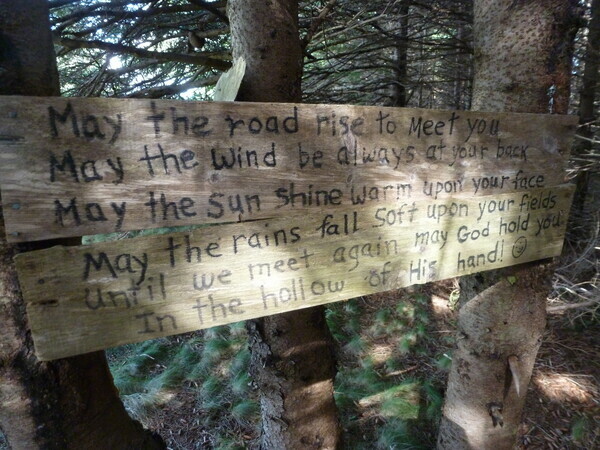

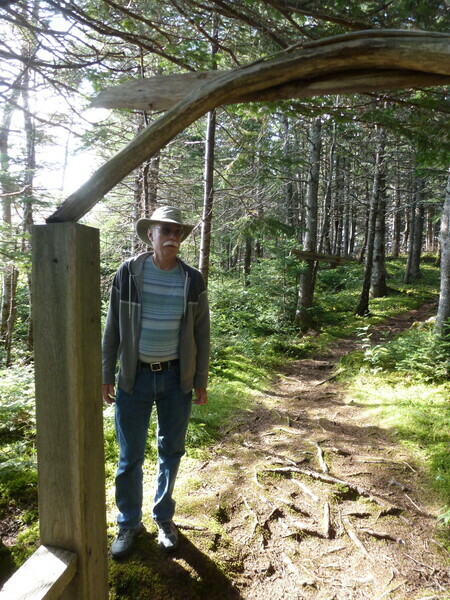
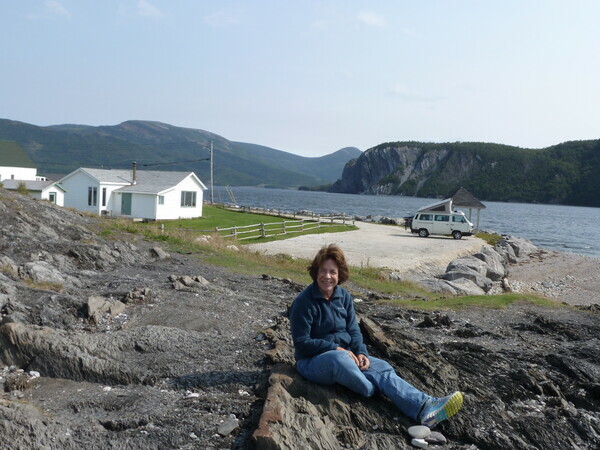
We then headed to Gros Morne National Park. Nearby, at Bonne Bay, we had lunch when...

...the National Geographic Explorer ship sailed into the bay. The ship provides tours to all parts of the world.

Nearby is the Bonne Bay Marine Station where ocean research is done. They have a public display that we went to. It was lucky for us that the National Geographic Explorer had arrived because the station is usually closed on Mondays but they opened it for the ship's passengers. We got to see and hear about various local ocean inhabitants like this blue lobster!
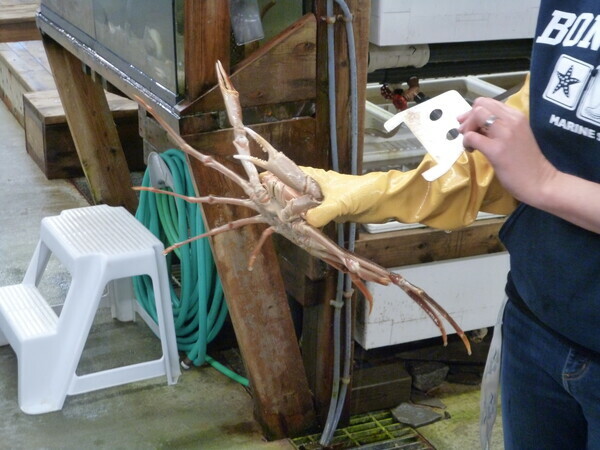
Crabs,
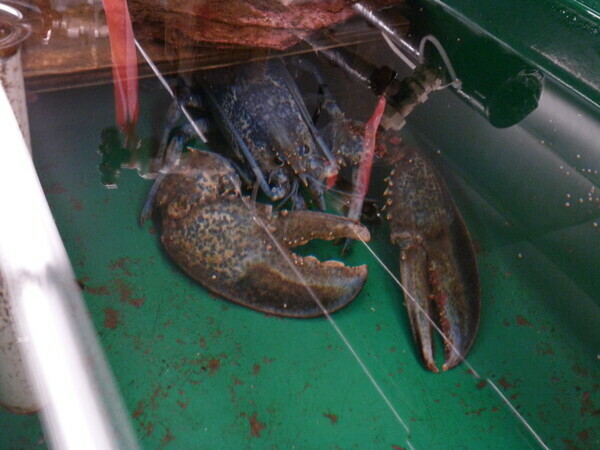
lobsters, this one had four claws but they are hard to see and...
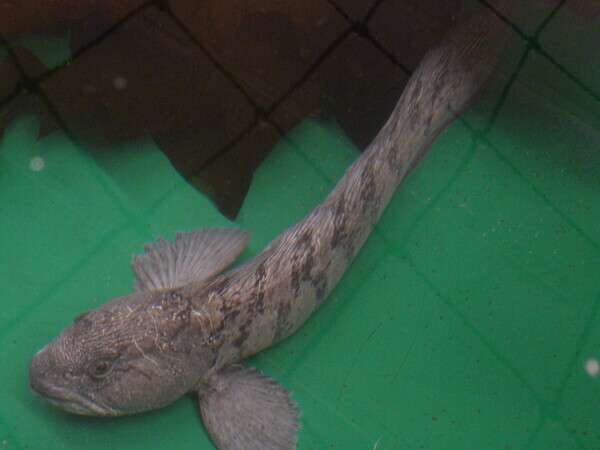
...a Wolf Fish.
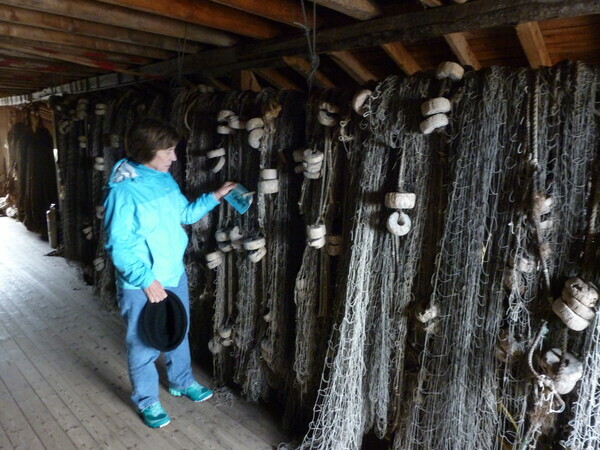
Fishing nets in the work shed.
At Broom Point we heard about how families would come from Rocky Harbor to spend all summer fishing. There was a little house for the three families, including four children. They spent all their time fishing and processing their catch for market. Cod was soaked in brine and then dried for a week. If it rained, they had to bring them in and then put them back out when it stopped. Cod can be dried because they have no oil in them, except the liver. Salmon had to be canned raw and then cooked for several hours.
The person telling us these stories was a fourth-generation fisherman. He still goes out in his boat every morning to check his lobster traps and then comes back for his Parks Canada job telling us the history. Since the fishing families had claimed these spots on the coast sometimes for six or seven generations, when the National Park took over, the fishing families retained rights to the land, beyond those of the Park.
Next, further up the peninsula...
Some people think that Cape Breton was originally part of Scotland which broke away. It has many of the same animals, plants and topography. The Clans have claimed it with town, river, and pond names. There are many annual meetings of the clans for singing, dancing, and lively Acadian music.

What would Cape Breton be without lighthouses? In the past, citizens of this community put a lantern on a pole to warn sailors of the cove entrance. Finally they were able to raise enough money to build a lighthouse.
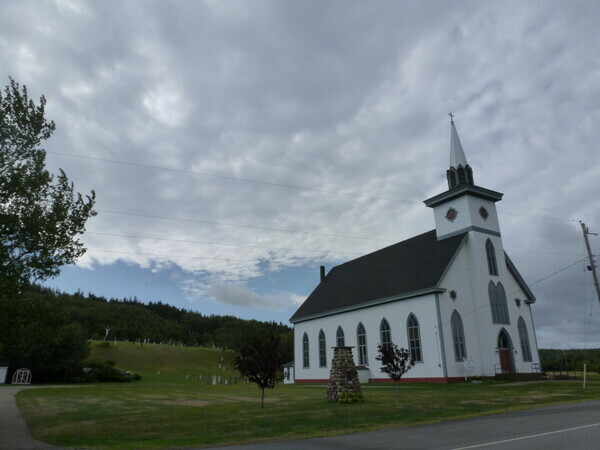
Alan and I love going into the old Churches we find along the way. Many are very simple and humble. They often have the grave yards alongside them. Sometimes the graves extend down to the sea cliffs. Very peaceful.
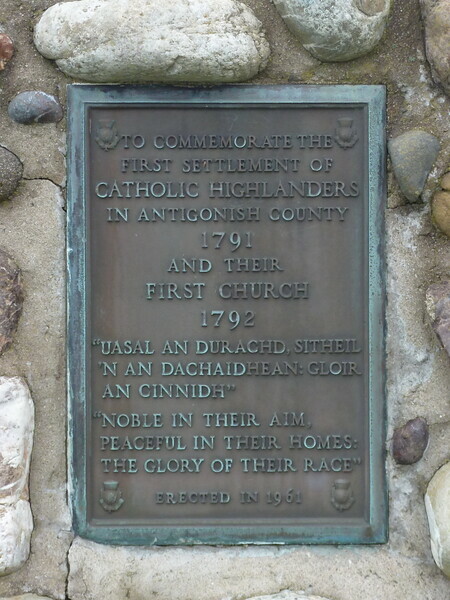
With a plaque like this, we figured the inside might be interesting.
The church was literally decorated with the tartans from a least 10 clans.
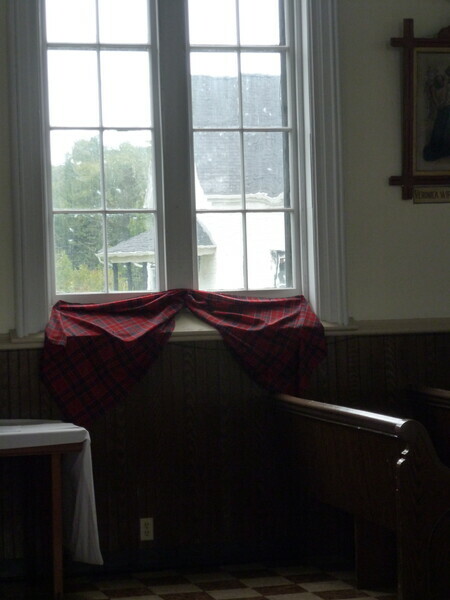
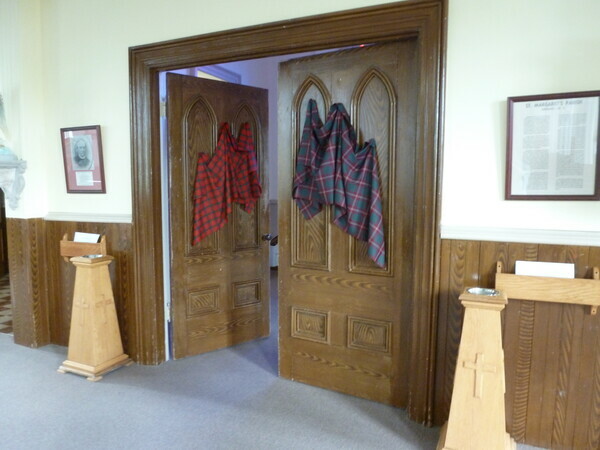
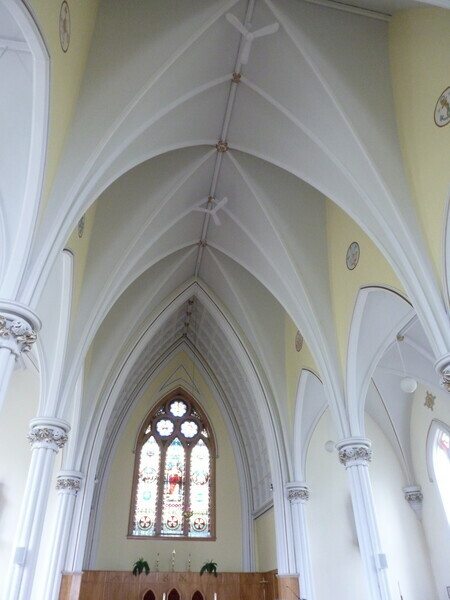
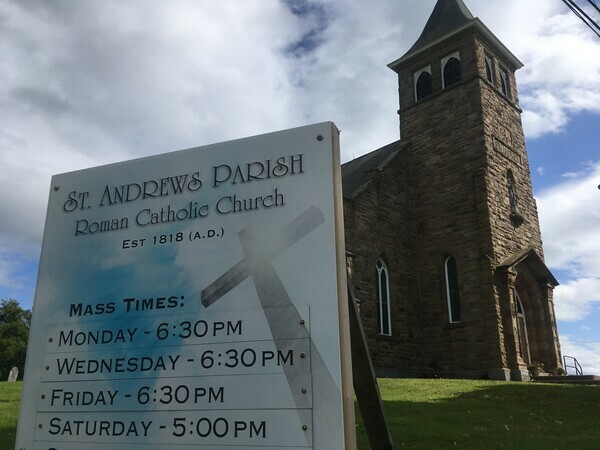
Here are a few of the interesting churches we saw along the way.
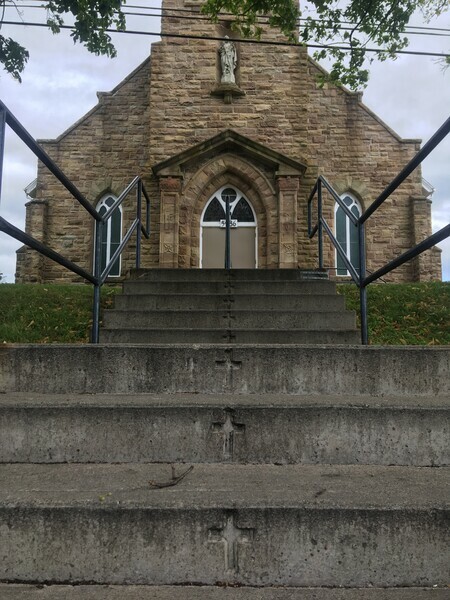
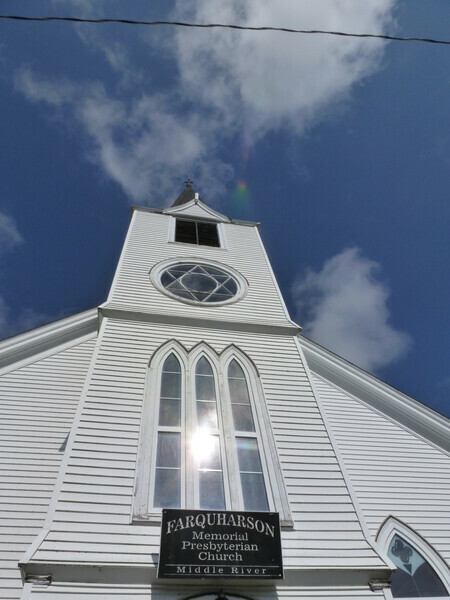


The types of graveyards were often unique and we were amazed at how many churches were left open.

This crucifix seems to be a recuring feature in a majority of the grave sites we saw.
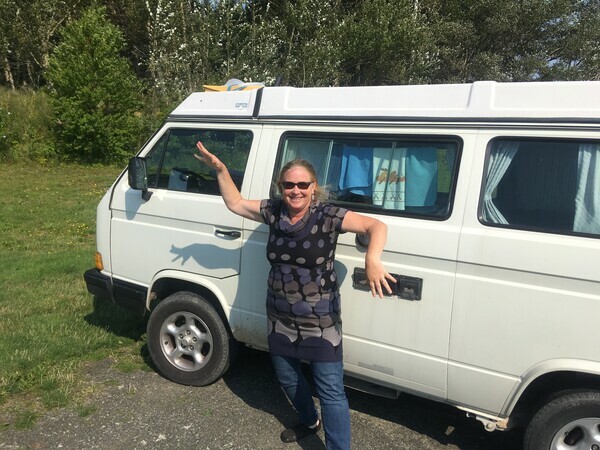
Here is our new friend Kristine. She works at the larchwood kiosk and has a Eurovan camper she loves. When she saw our van, she rushed outside excitedly! We exchanged van stories and how she loved living in Cape Breton. To make our visit more enjoyable, she told us of an authentic Acadian home-restaurant for us to explore.

We almost missed it since from the front it looked like the other houses. The owner cooks right out of her own kitchen. Her specialty is meat pies but her menu includes many items unique to this area.
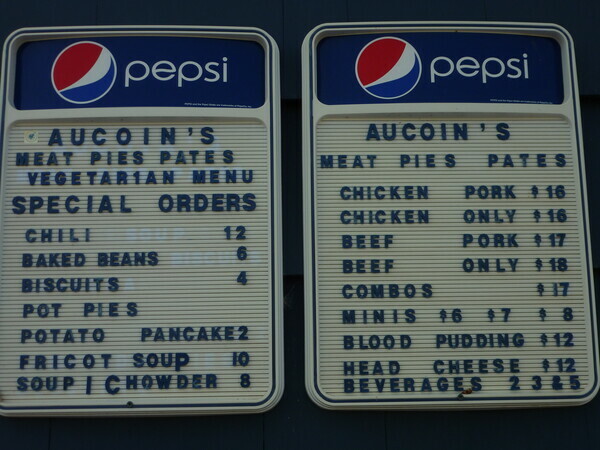
Here is the menu. She told me how she made the blood pudding and how tasty it is. Well, we aren't very adventurous so we picked the Fricot Soup and the Chicken meat pie. Maybe next time.......
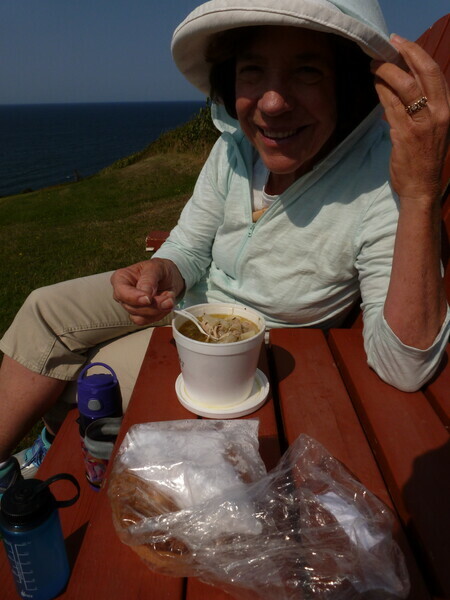
Here is Mary Ann enjoying a very special chicken soup called Chicken Fricot. It was the best chicken soup she had ever had! It has potatoes and special seasoning called Summer savory. It was delicious!!!

Alan enjoyed a chicken meat pie brimming with meat. The dough was like bread rather than crust.

The owner invited us to eat on the rise above her house. What a meal! What a view! What a special memory! We were the only ones there, it was magic!
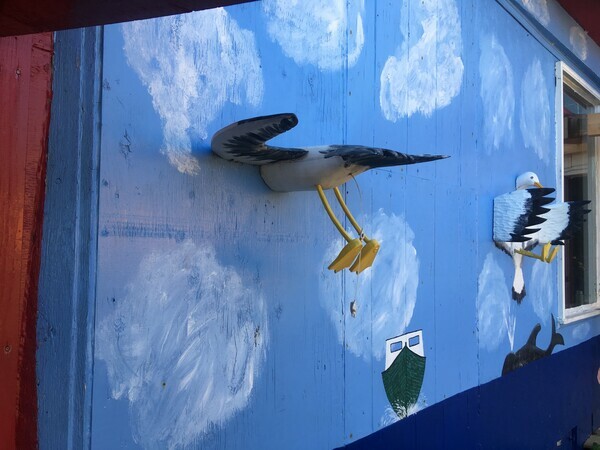
This is a creative mural outside the coffee shop Kristine told us about. It is called the Happy Frog and is in a group of shops that have an artist studio, gifts, and a patio complete with a Harpist!!! What a way to start the day.
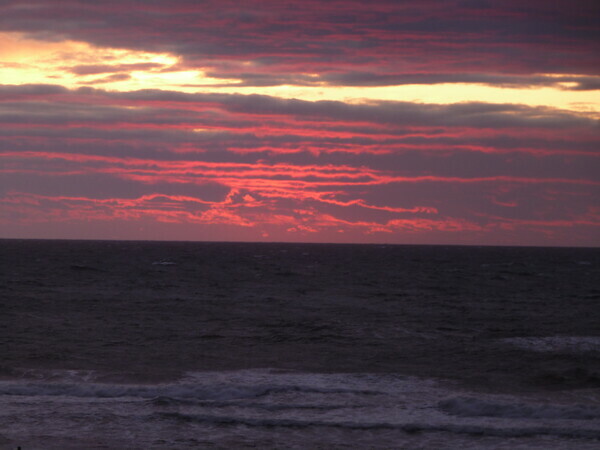
We scored a great campsite right on the bluffs in the Cheticamp National Park. This is a view of the sunset that evening. We were pretty pleased until the wind kicked up during the night. It was so strong that the van rocked and we felt like we were sleeping in a balloon!!! Finally we pulled the top down, somewhat, and tried to sleep on the seats inside the van. In the morning one of the campers said that this site had been shut down due to the wind 2 days earlier for campers safety.

After the wind, calmness and beauty!!
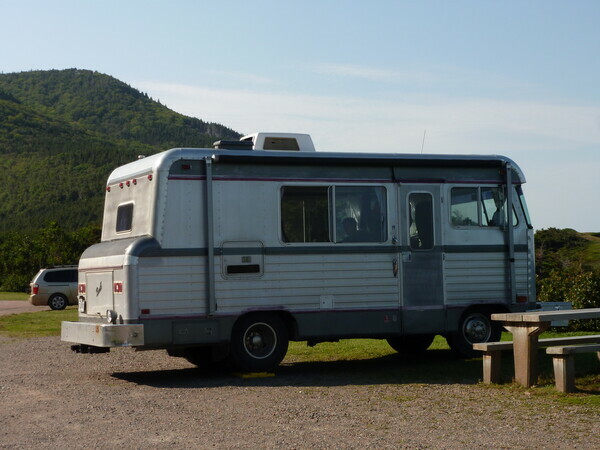
Met a family from Quebec that were taking time off from school for themselves and their two kids. They were driving a Barth motor home from the 1970s. They hardly knew that the wind had blown.

Another Cheticamp sunset.

Followed by a Cheticamp full moon set early the next morning.
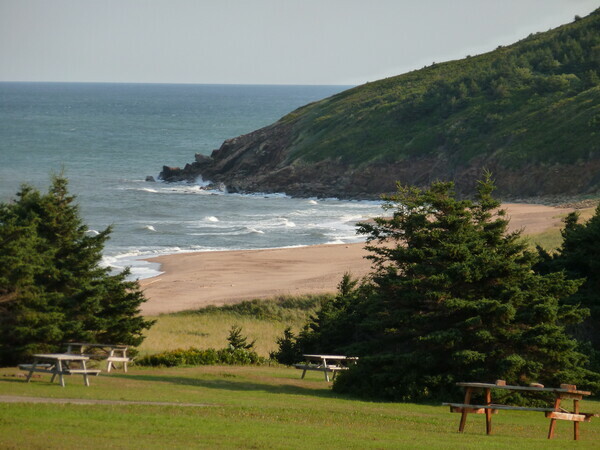
This is another spectacular camping spot call MacLeod's. Here we saw a group of people who leave their trailers on the grounds through out the winter. They split up and go back home or to warmer climates for the winter. The next summer they reunite their little village of friends. Similar to the fishing villages of the past, we now have camping villages.
Next we move to North Sidney where we catch the ferry to Newfoundland.

The Nova Scotia Visitor Center, as we entered from New Brunswick.
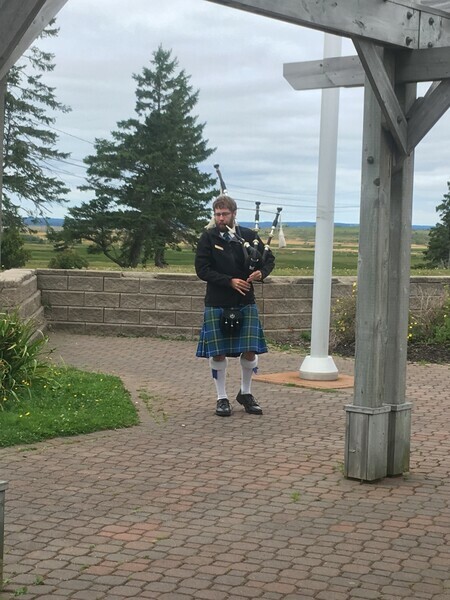
One of the Visitor Center played his bagpipes for a while while we ate lunch.
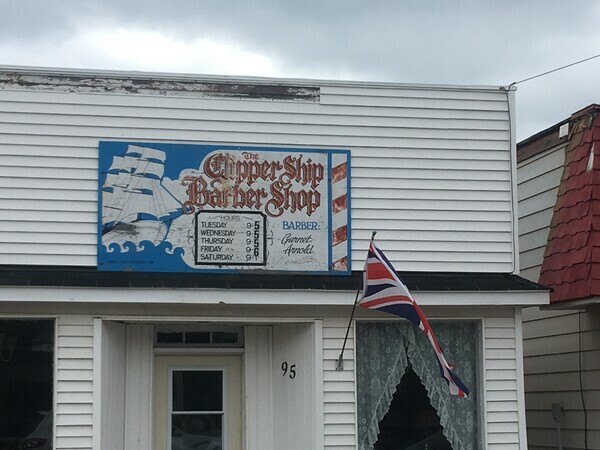
I wish we had photographed all the catchy and creative business signs we saw along the way.

One of our favorite places is Pugwash. This is where, I think starting in the 1950s, prominent scientists came together to try to figure out world peace. They had figured out atomic energy and cosmic theories, and figured they should try something even more practical and useful.

This explains more about the Conferences.
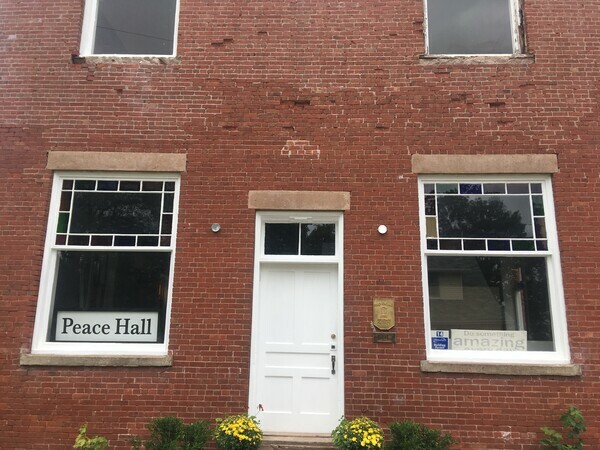
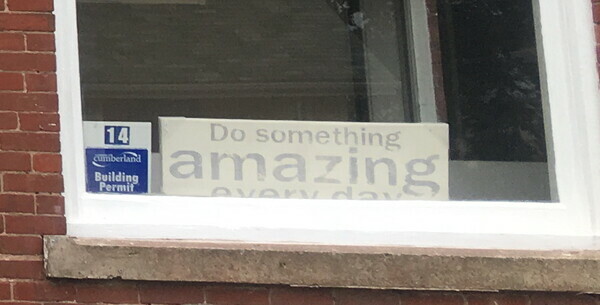
The sign in the right window says "Do something amazing every day".
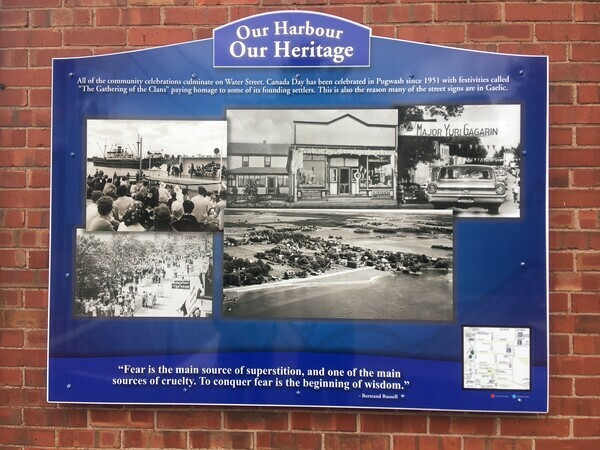
More about Pugwash.

As the previous photo explained, street signs are in English and Gaelic.

The office of our favorite Nova Scotia campground.

Our campsite on the cliff over the beach.

Another view of the campground. Way across you can see Prince Edward Island, of Anne of Green Gables fame.
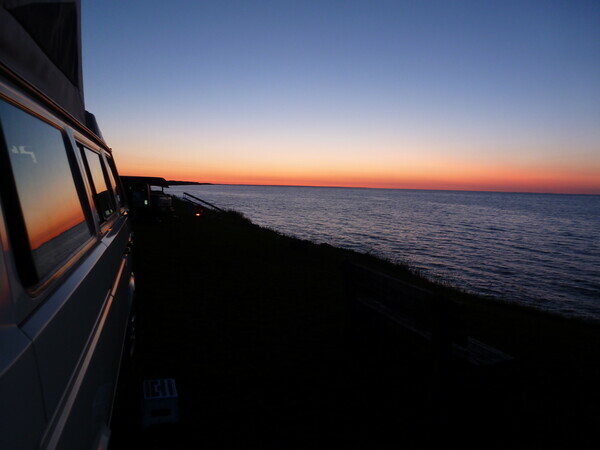
One reason we like this particular campground is the great view of the sunsets. They last a long time, up to an hour even.
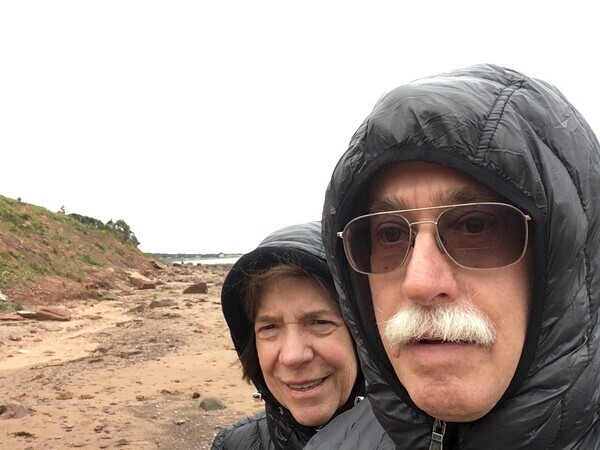
The view was great, but also was the cold wind on the beach. This is the day it was very hot in San Diego.

We met a nice family from Halifax who also think this is a great campground! Brianna, Drew, and their niece and nephew.
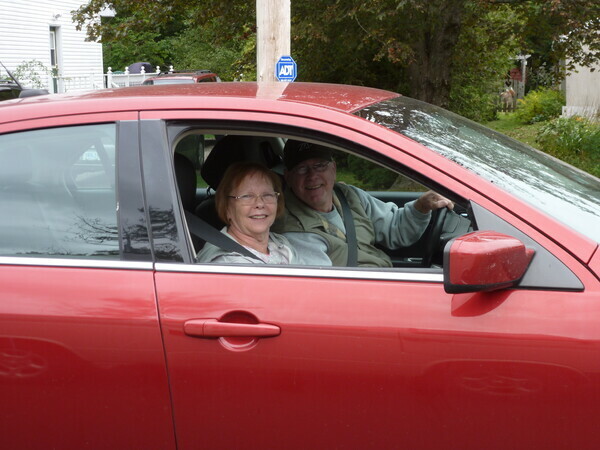
Driving through a little town, we had to follow a detour due to some construction. I stopped to look at my iPhone map to make sure we were on the right track, and this nice couple stopped to see if we needed help.They confirmed the route we needed to take so we continued.
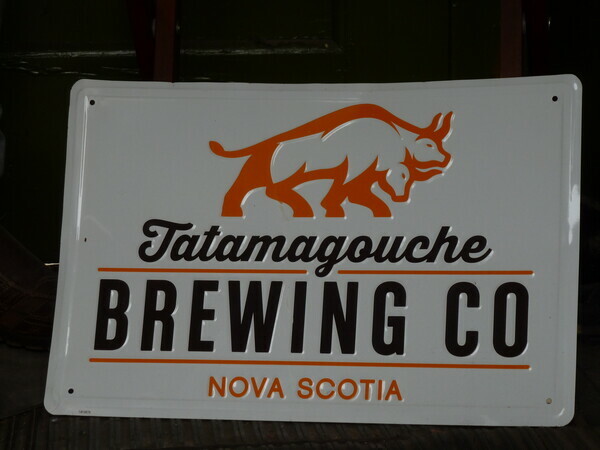
Before we left on the trip, our friend, Julie, told us her ancestors had come from Tatamagouche and River John, both of which were on our route.
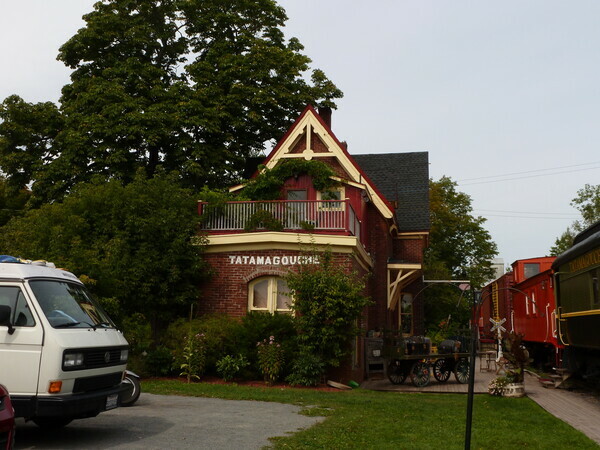
Tatamagouche is a larger town and is on the railroad line. They have restored their station and some rail cars. You can eat on an old dining car and sleep in a car too.

At the train station gift store, we found this van ornament and couldn't pass it up.
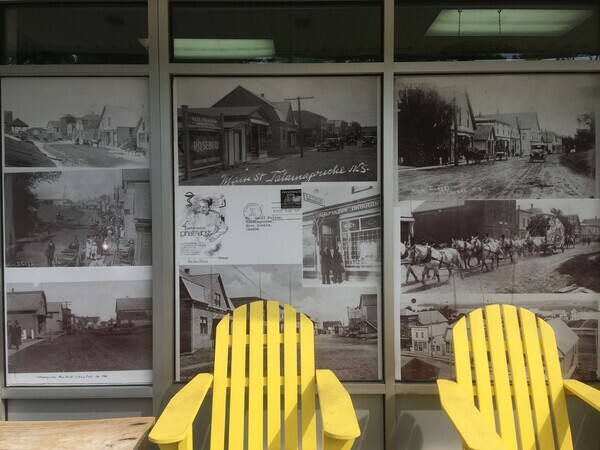
On a store front were some old photos showing the town long ago.
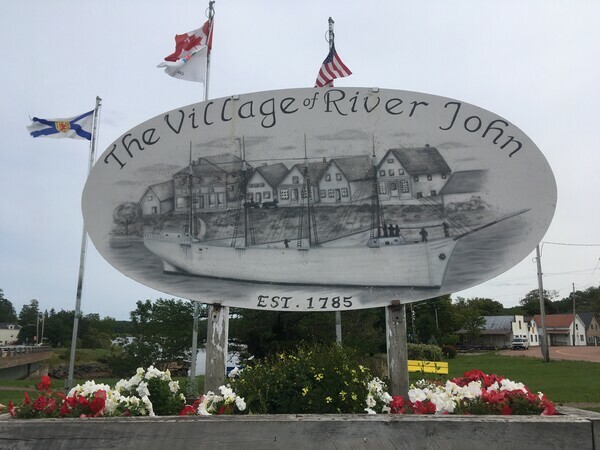
River John is smaller, but cute. We had lunch by the river behind this sign. Can you see the van?

Some interesting decorating of the bushes along the road.

The route along the Nova Scotia western shoreline.
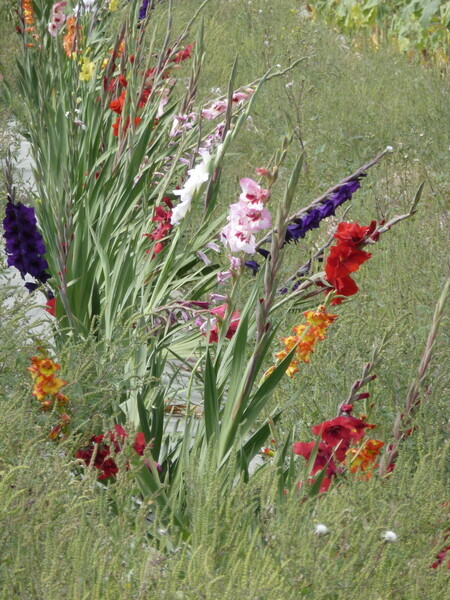

Flowers along the way.

Flowers grown outside are cut, displayed, and sold inside a vegetable stand/bakery place.


Imaginative road sign.
Next, Cape Breton Island, the northern half of Nova Scotia.
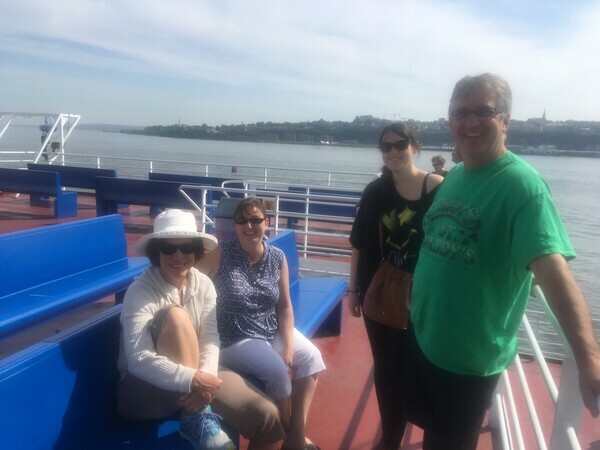
The old part of Quebec City is on the north side of the St. Lawrence River, but it is difficult to park there. We parked on the south side and took the short ferry ride over. On the way we met a family from Halifax.
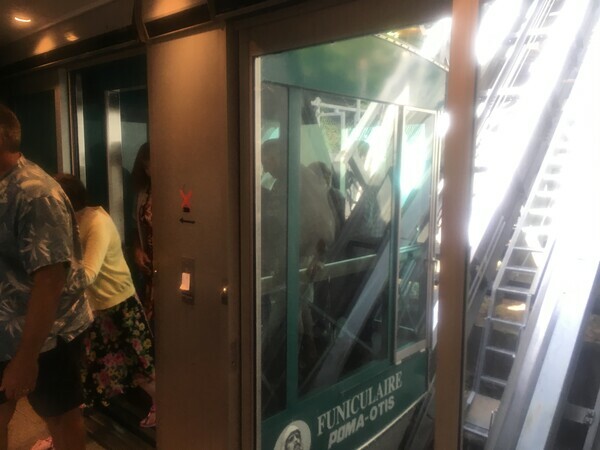
The old city is on a plain above the river (The Plains of Abraham) so we rode the funicular to the Chateau Frontenac.
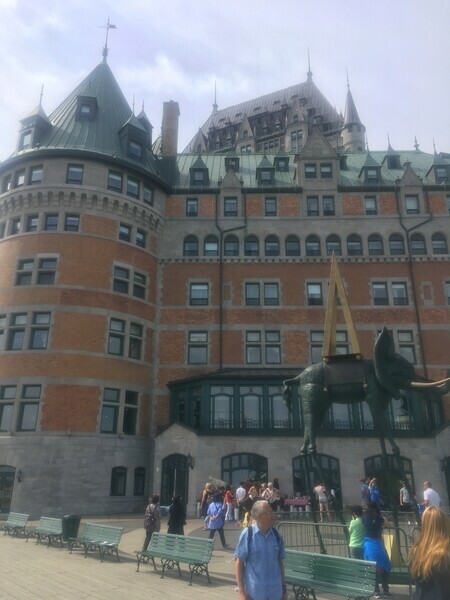
Here is the front of the Chateau, with an elephant sculpture by Salvador Dali...

...and a memorial to Samuel de Champlain, who founded Quebec City in 1608.

We took a break in front of the Chateau and watched the world go by. At the next table was a couple we had met earlier in the day at an information center many miles away.
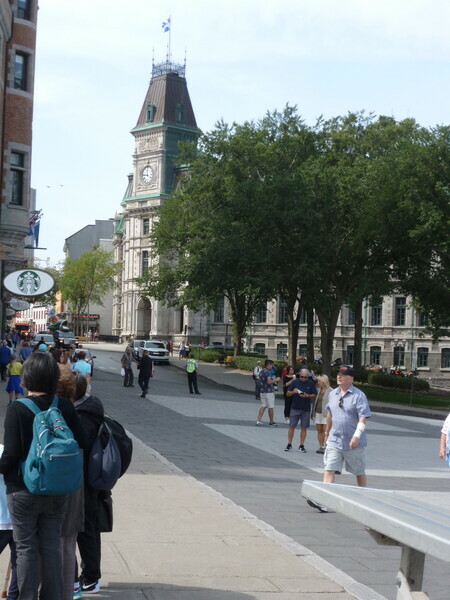
We took a narrated tour on a double-deck bus around the city. Following are scenes from the tour giving a taste of the architecture.
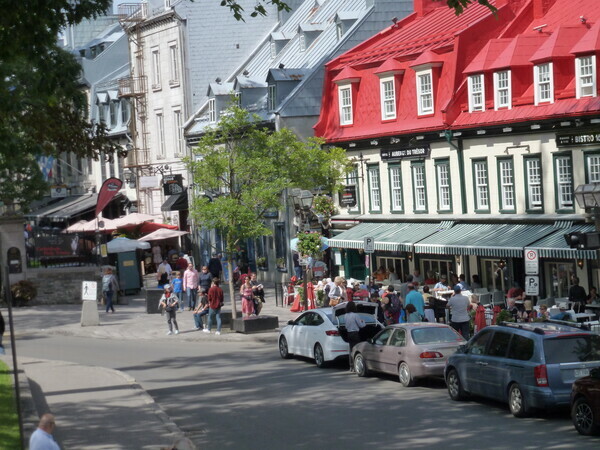

Some architects perhaps got carried away.

This is the top of a church showing a saint and his dog. The dog had somehow saved his life. And, of course, this church has a frequent blessing of the animals.

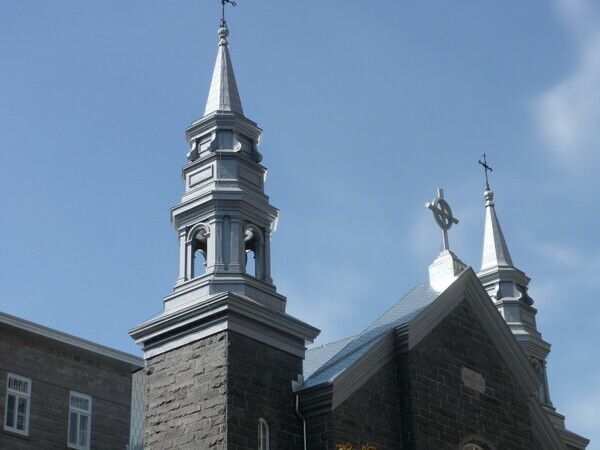

A typical sidewalk view.

The Plains of Abraham. This is where a significant battle took place in 1759 in which the English scaled the steep cliffs from the river at night, surprising and defeating the French in the morning.
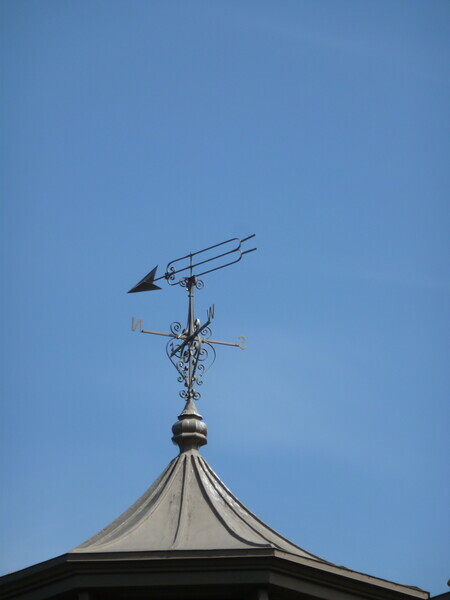

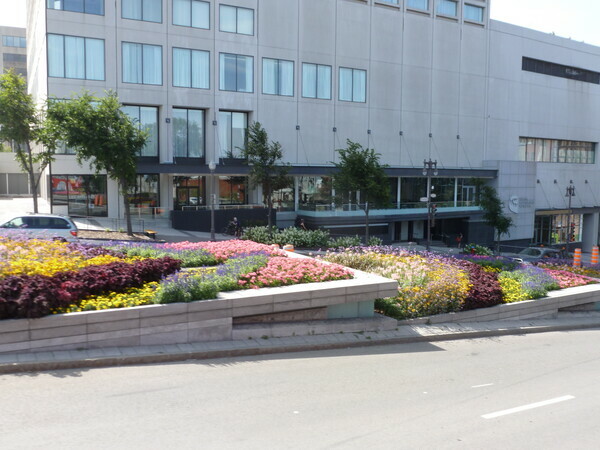
Canadians seem to love flowers, perhaps because in winter outside is so bleak.
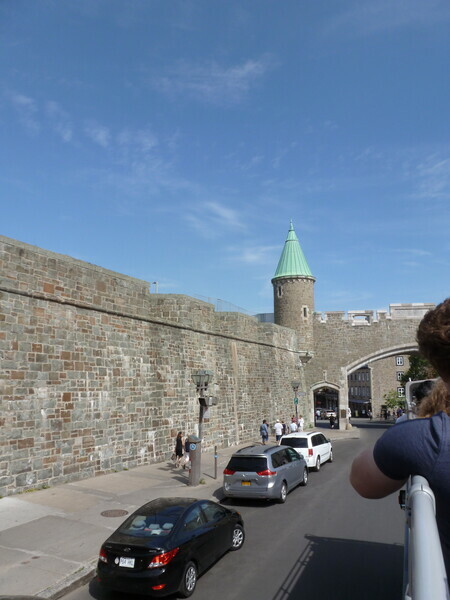
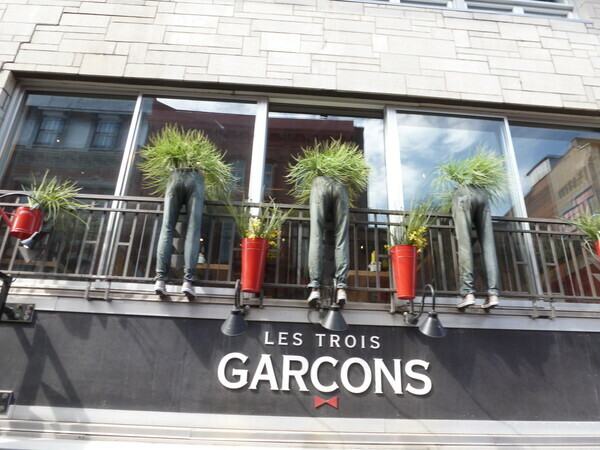
The name translates as "the three boys". It is an "industrial-chic eatery".

More flowers, and, if you look closely, some frogs. (Significant in a French-speaking province?)
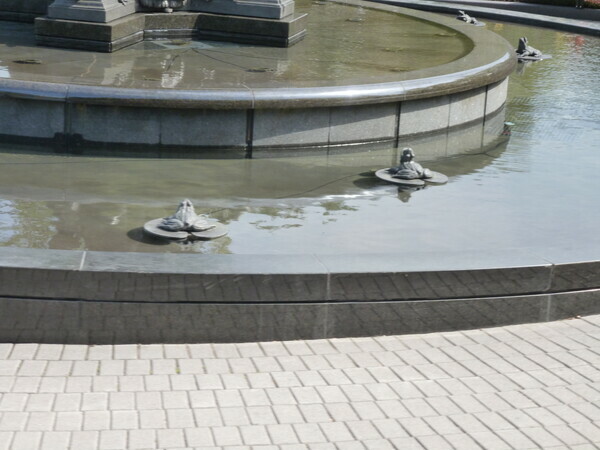
The frogs.
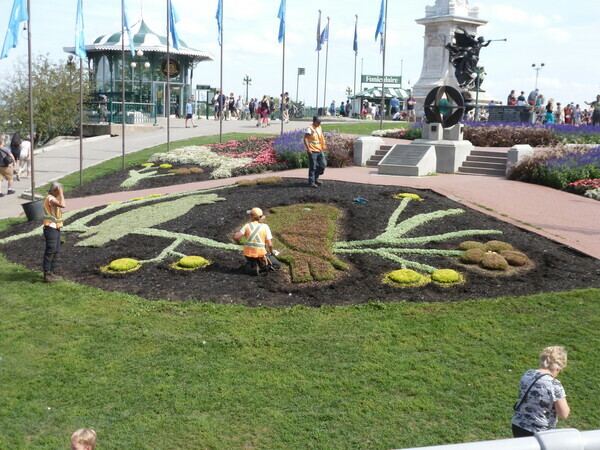
They keep their public gardens well tended. The Canadians take saying it with flowers to a new height.

A better view of the roof of that earlier building.
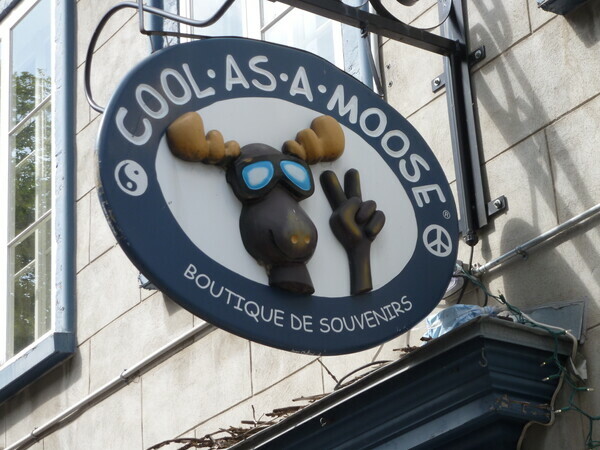
Couldn't pass up this sign.
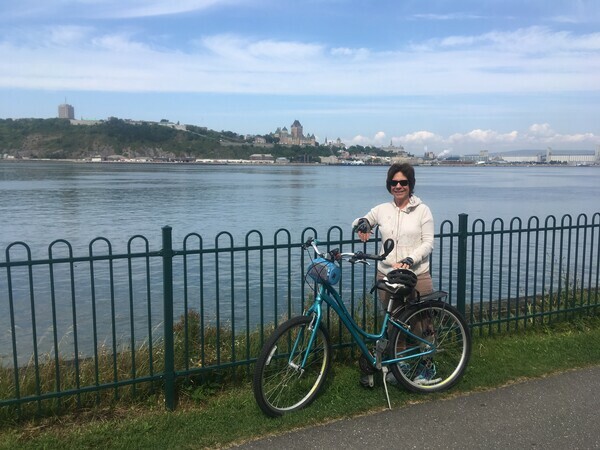
After the ferry ride back to the van, we noticed this really nice bike path along the St Lawrence. People told us you can go quite a ways, even into the countryside. We headed upriver and enjoyed the ride quite a bit.

It is divided so bikers, skaters, skateboarders, and walkers can share the path.
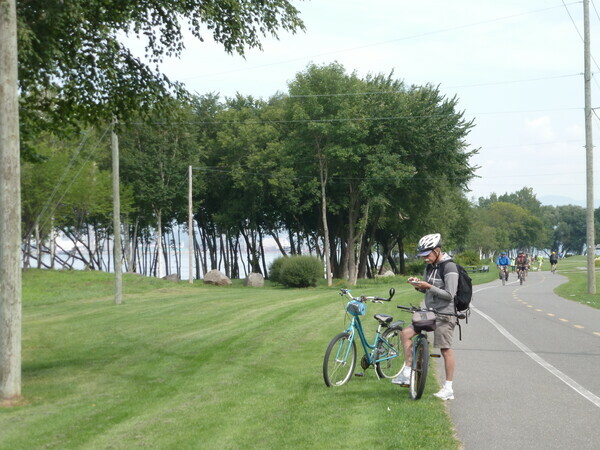
There were several little parks along the way.
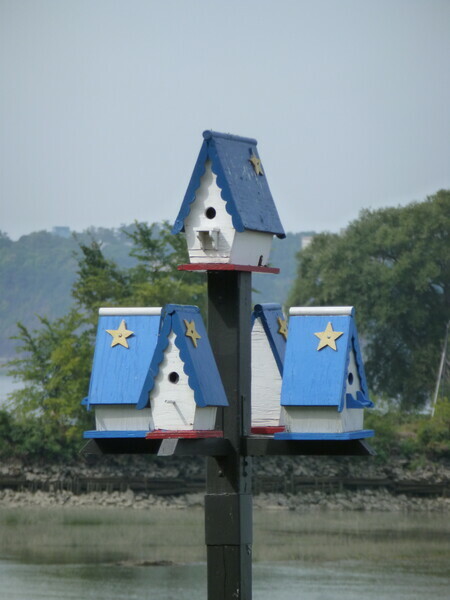
And a bunch of birdhouses.

And birds.
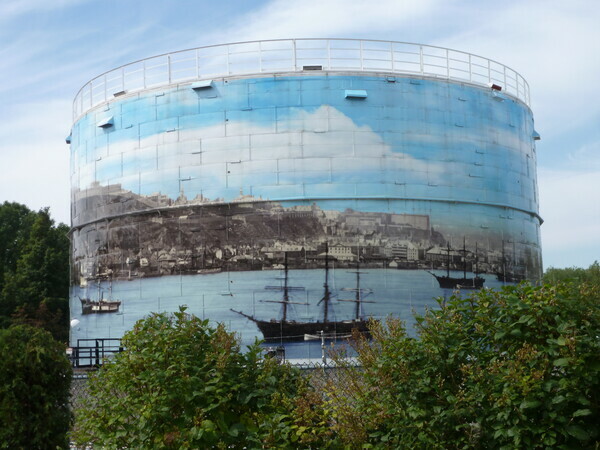
The Valero oil refinery is up on the cliff. They are trying to make their tanks a little more scenic.

Speaking of creative architecture.
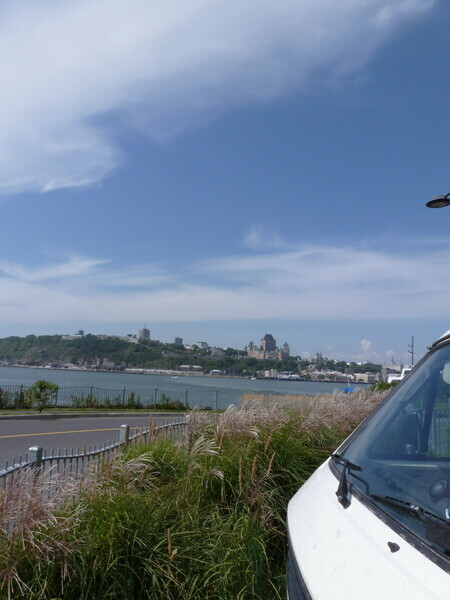
The van with Quebec City across the river, before we headed downstream to one of our favorite campgrounds.
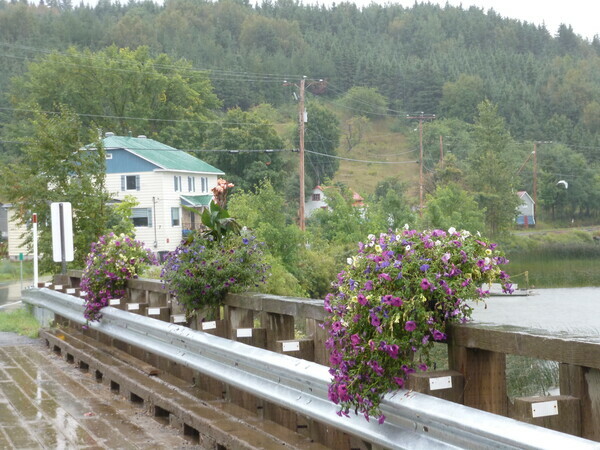
Along the way.

The lake from the top of the campground.

The van with a village church in the background. Most of the church steeples along the St Lawrence are aluminum colored. I think I remember hearing it had to do with manufacture of aluminum being a local industry (at least at one time). At night this church has a golden glow, like those in Italy.

A shrine along the road.
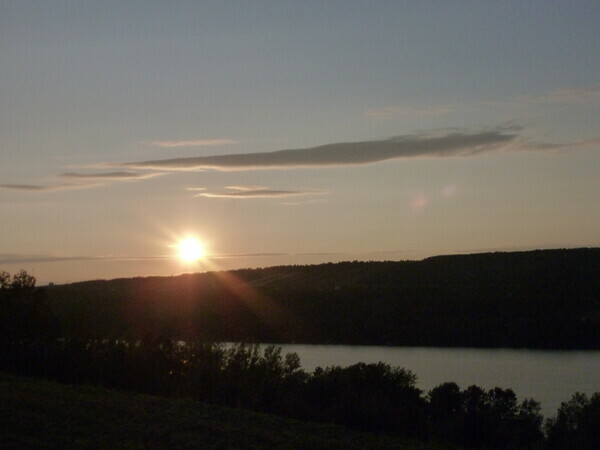
Sunset over the lake from our campsite.
Next, towards Nova Scotia.